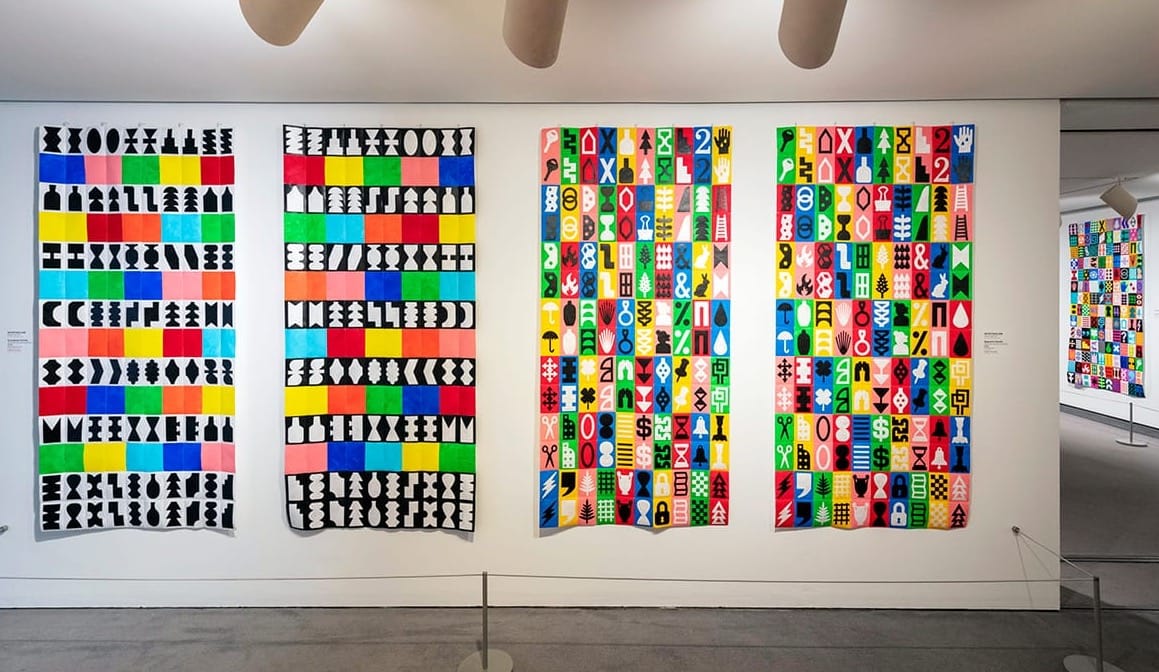A joyful celebration of Wichita drag artists: Lydia Humphreys at CityArts
At a fraught moment for drag artists, Humphreys' exhibition celebrates the creativity and self-determination inherent in drag. It's on view through February 23.
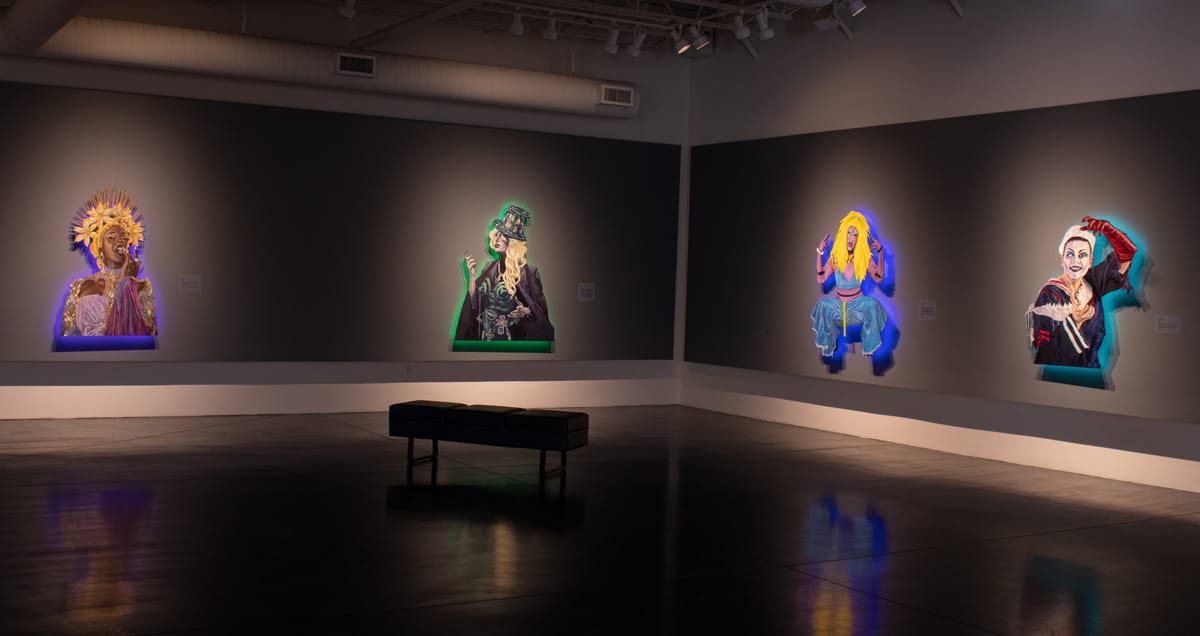
In one corner of the gallery, a star poses for photos and in another a burlesque dancer perches precariously on their six-inch heels. An alien squats and flips a double middle finger salute, and a queen licks something decadent from her fingers. They, and many others, are the subjects of Lydia Humpheys’ latest body of work: “The Fluidity of Expression,” a series of portraits of drag artists who live and work in the Wichita area. Drag can be considered a performance art: The body, character, and amplified fashion are the canvas for a new persona that performers uses to express something about themselves — and often about the culture at large.
In "The Fluidity of Expression," on display through February 23 at CityArts, 344 N. Mead in Wichita, Humphreys utilizes the tradition of portraiture to elevate local artists. The exhibition is a sanctuary that honors and celebrates self-determinism, and Humphreys' dedication to collaboration lifts up and acknowledges the diversity and strength of our local queer community.
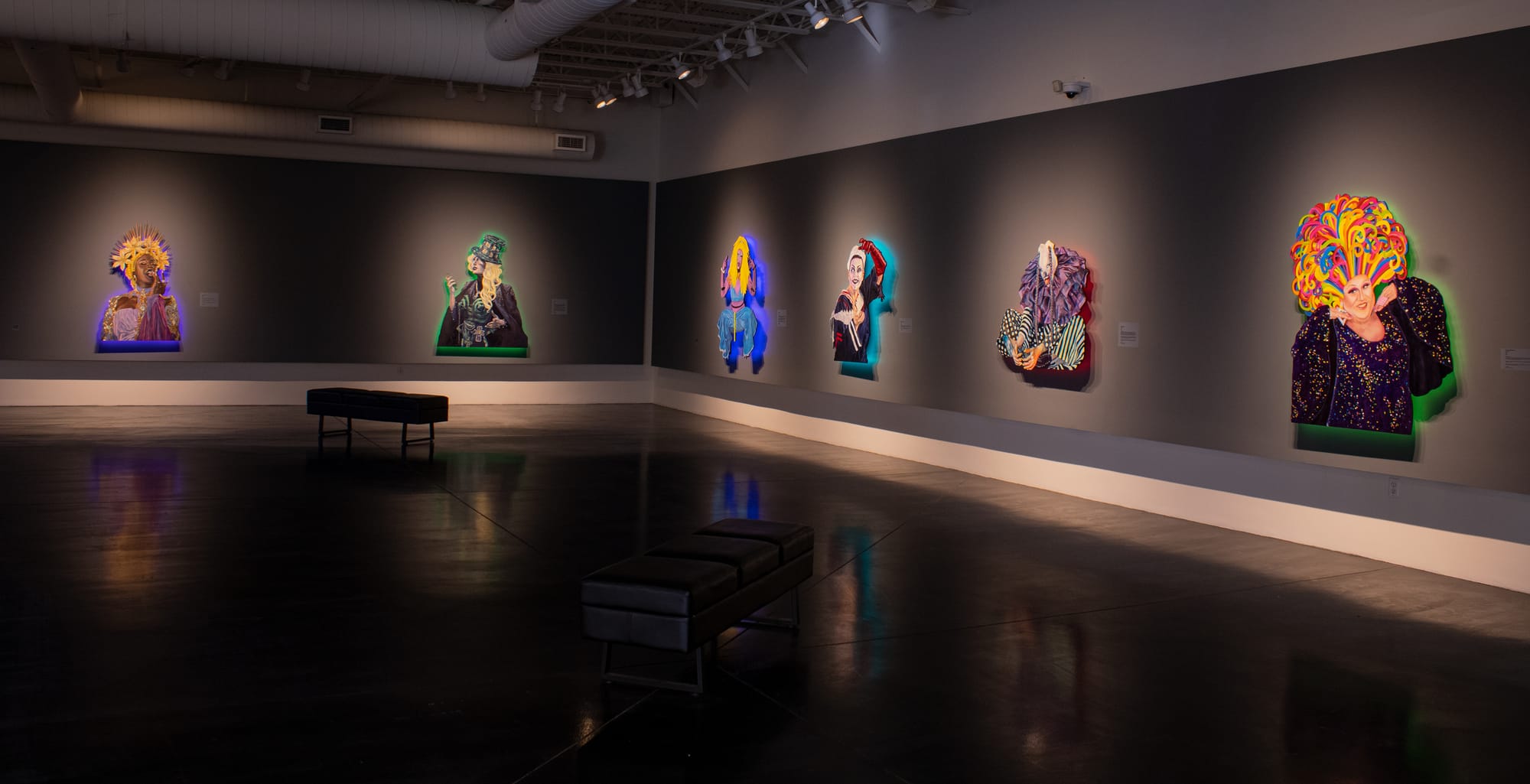
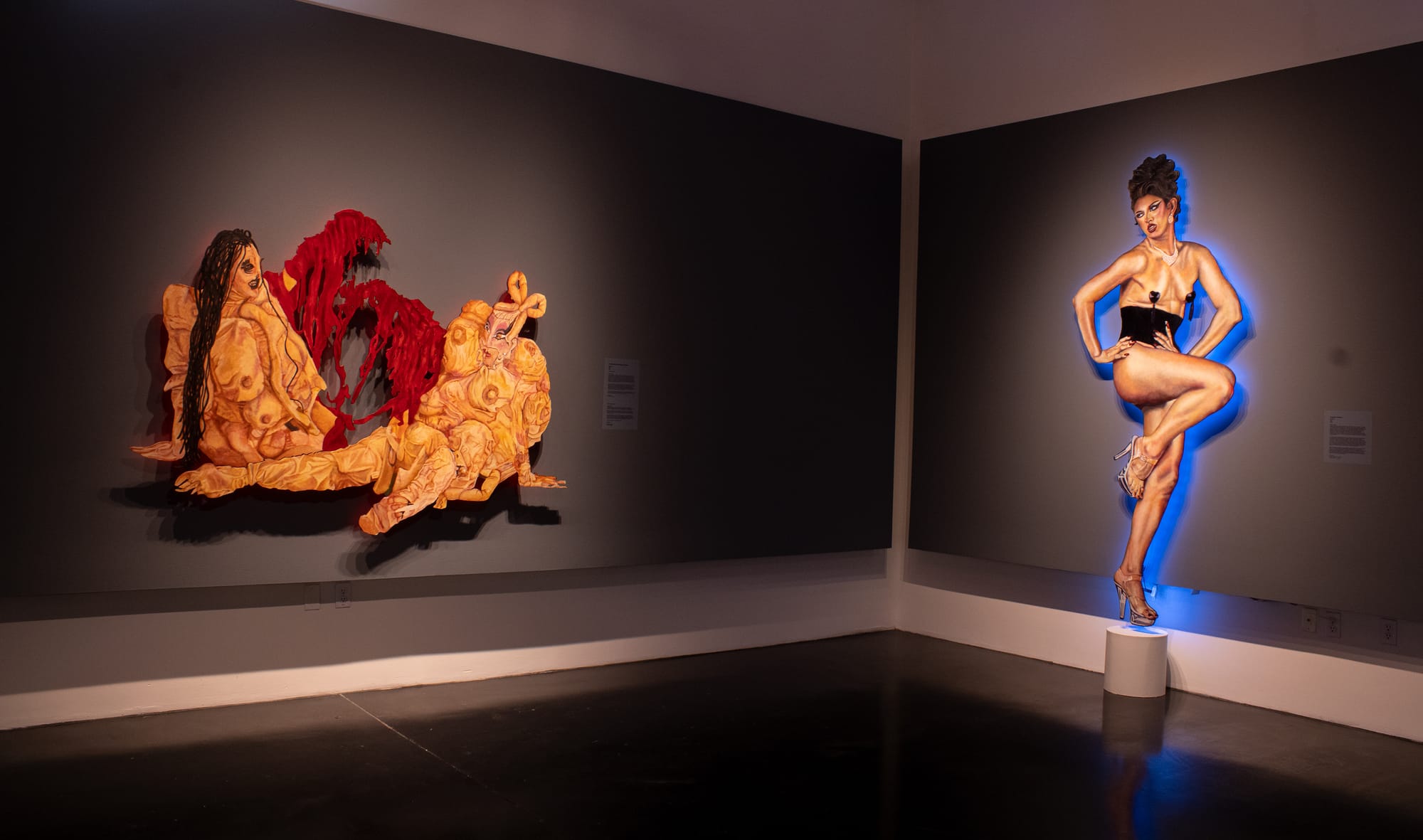
Installation views of "The Fluidity of Expression," on view in the CityArts Main Gallery through February 23. Photos by Olivia D'Laine Schawe for The SHOUT.
The process for each oil painting begins when Humphreys and the drag artist agree to work together. Humphreys schedules a photo shoot during which the artist has the opportunity to change between several outfits and looks. While each drag artist brings out their character, Humphreys picks angles and changes the lighting to create different compositions.
Sign up for the Weekly SHOUT, our free email newsletter
Stay in the know about Wichita's arts and culture scene with our event calendar and news roundup.
No spam. Unsubscribe anytime.
After the photo shoot, Humphreys selects a single image to work from and sketches the outline onto a wooden panel. They cut the silhouette from the panel by hand, following the contours of the figure’s body, hair, and accessories. Then the long task of painting begins. To further incorporate the drag artist, Humphreys also displays a statement by the subject that describes their relationship to drag.
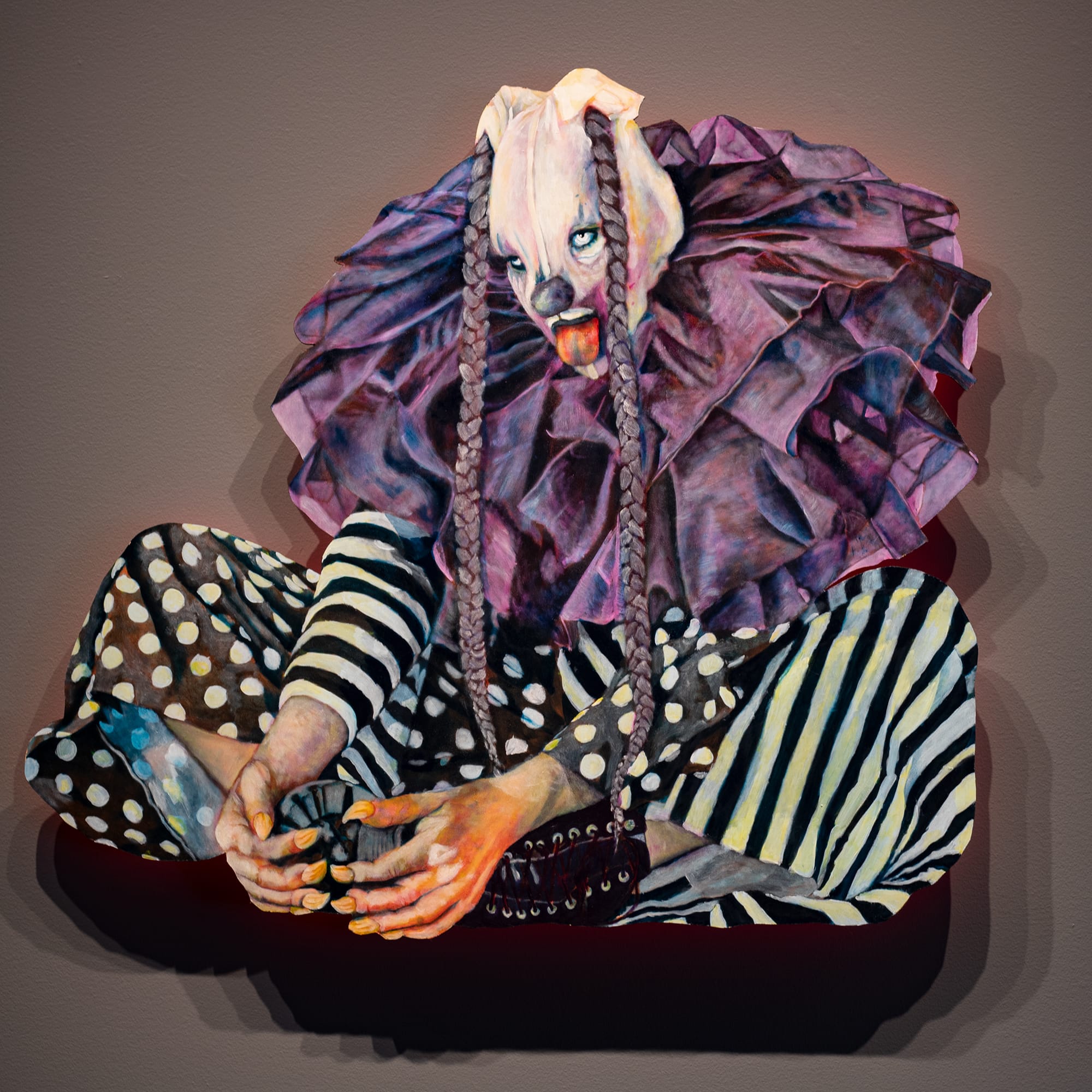
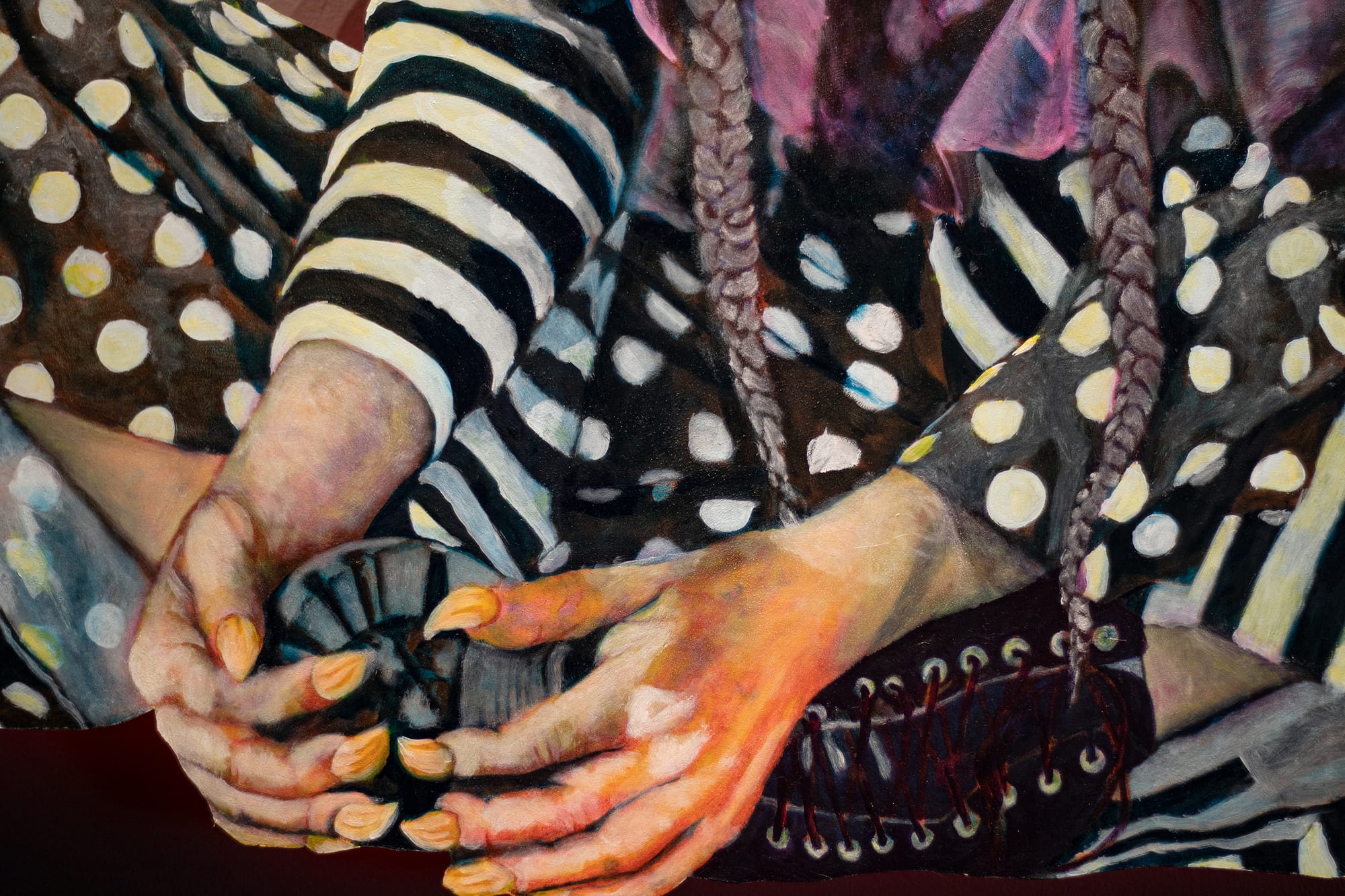
From left: Lydia Humphreys, “Aero Decay,” 2024, oil on panel, 42 by 46 inches; detail of "Aero Decay." Photos by Olivia D'Laine Schawe for The SHOUT.
In these works, Humphreys applies oil paint on the panel in translucent layers, rendering each portrait using a glowing interplay of colors. The piece “Aero Decay” depicts the performer in stripes and polka dots, seated with their legs bent in a butterfly stretch. One of the figure’s hands holding their combat boot seems to glow with vivacity, while their collar’s many layers in shades of purple shimmer between the colors. Spotlights shine on “Lounixa Cadaver." Here the subject poses on a pedestal in platform high heels, a black corset at the waist, nipple tassels, and little else. The painting shows off the shine of her heels and the luminescence of her flesh and the pearls she wears.
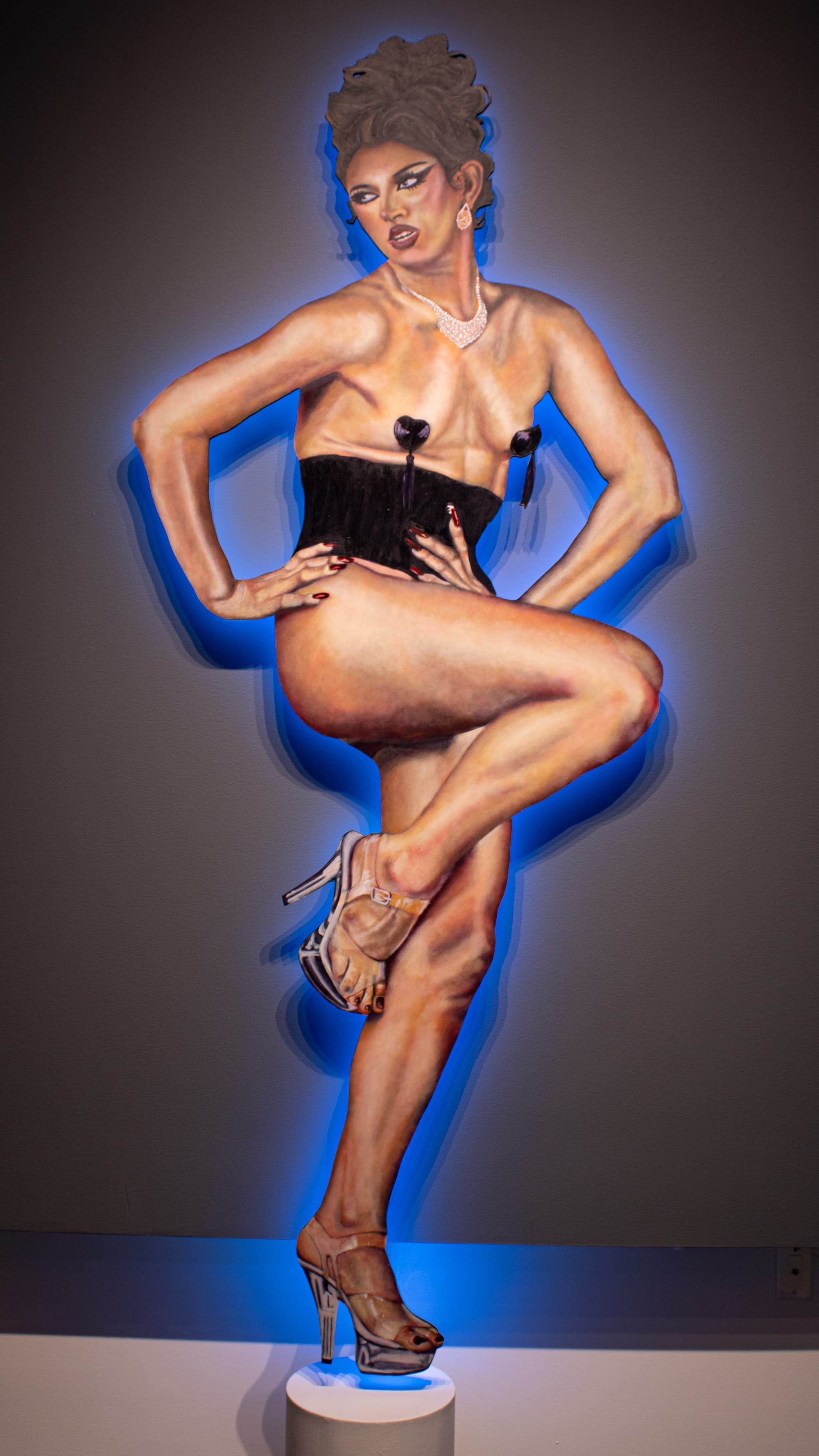
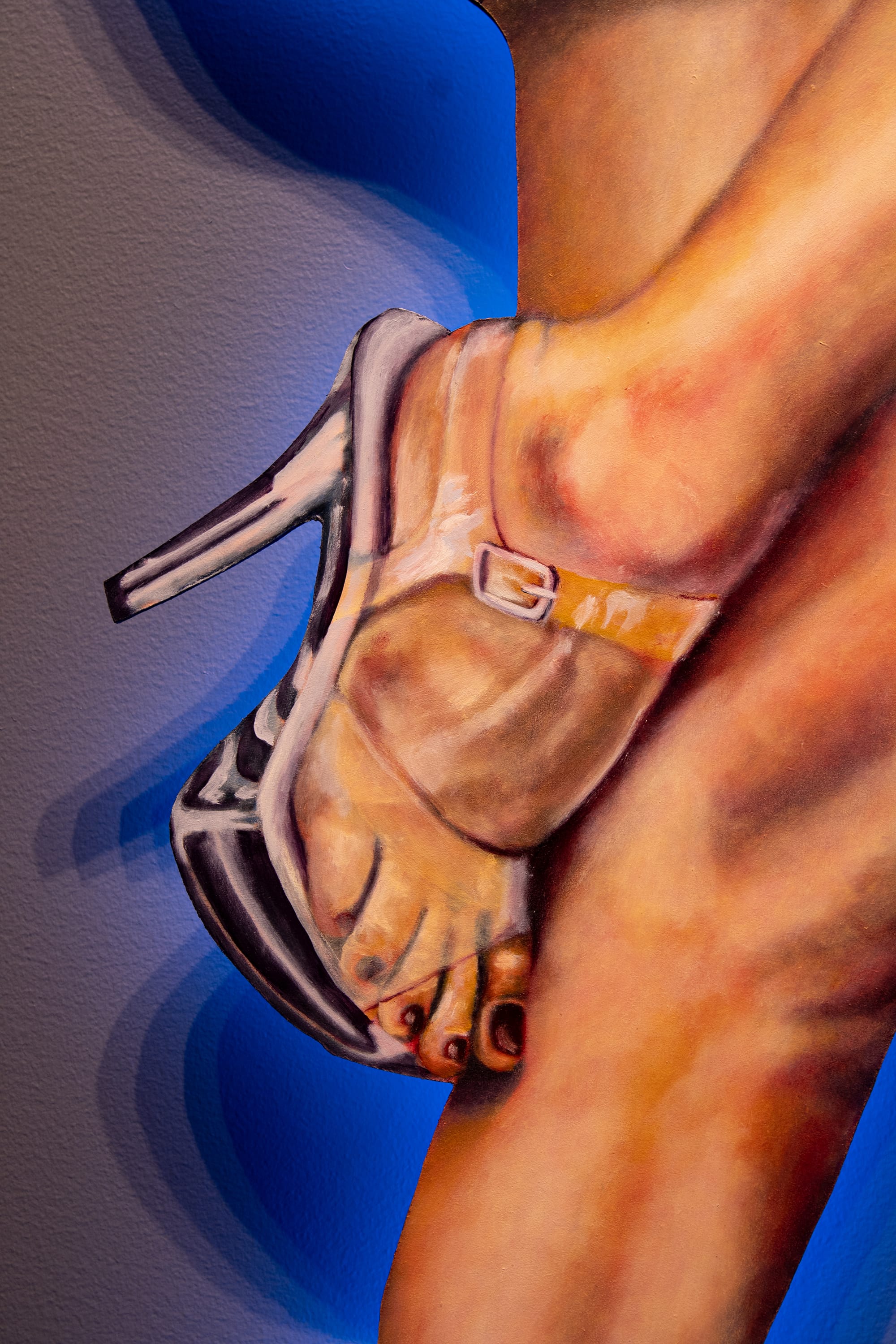
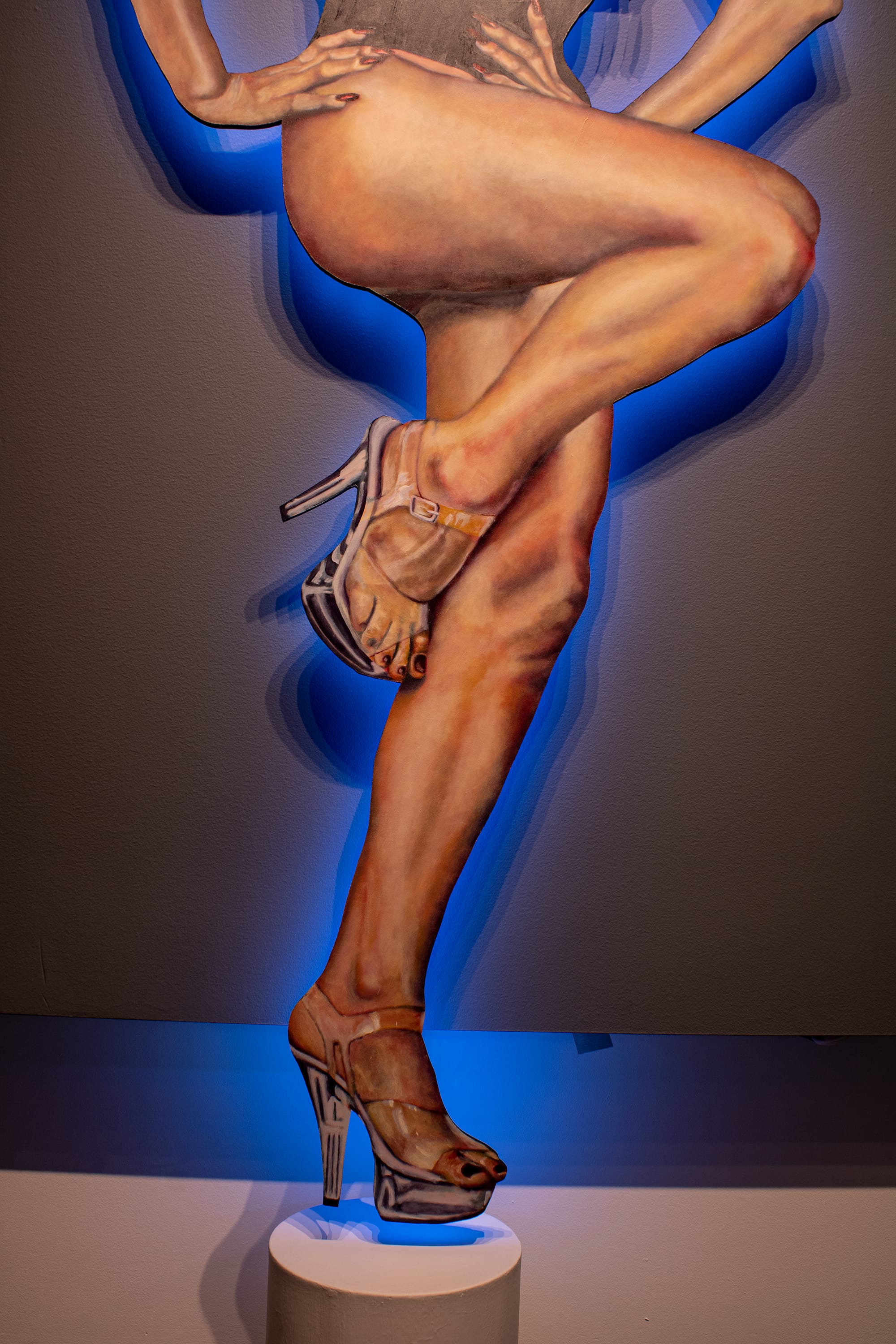
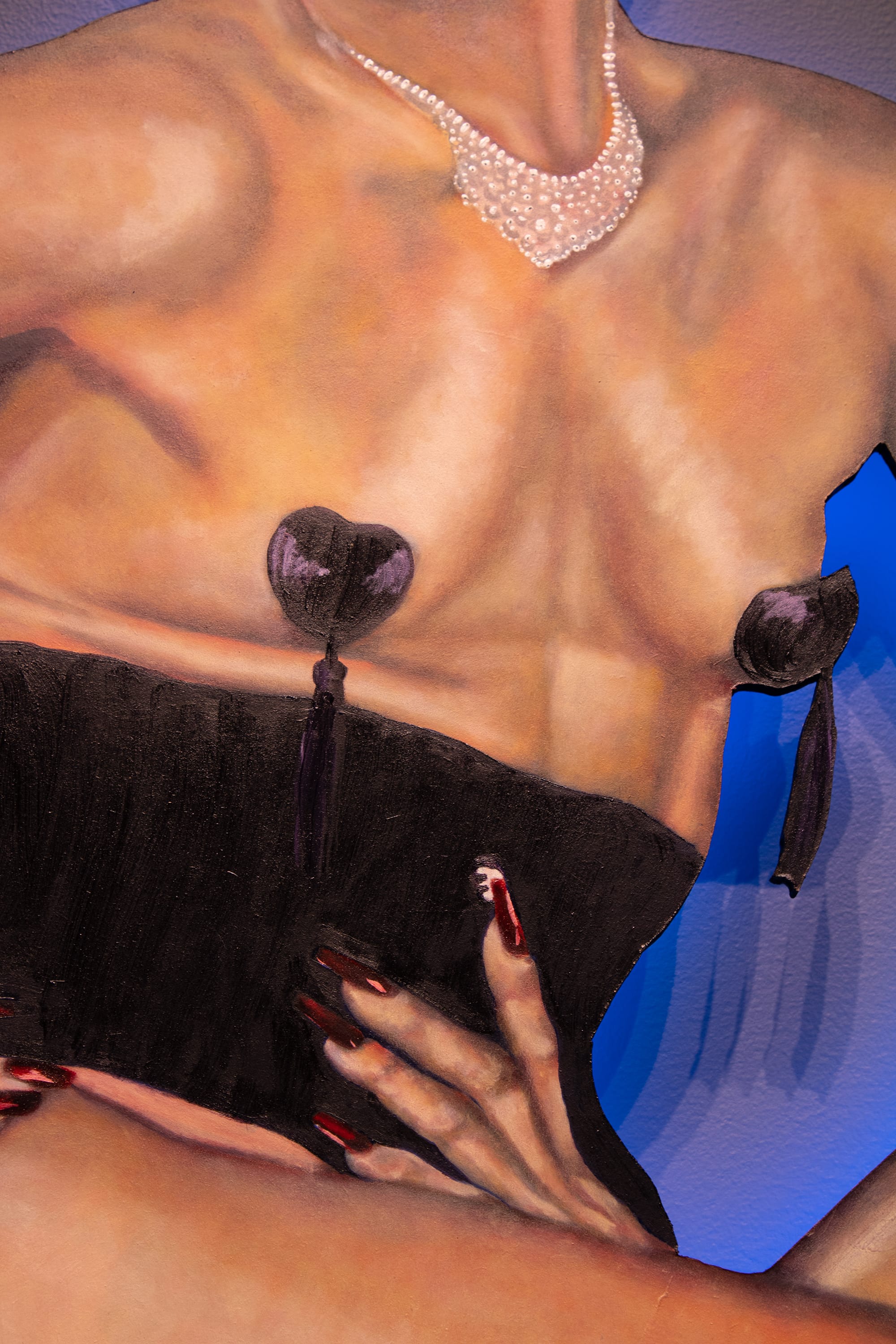
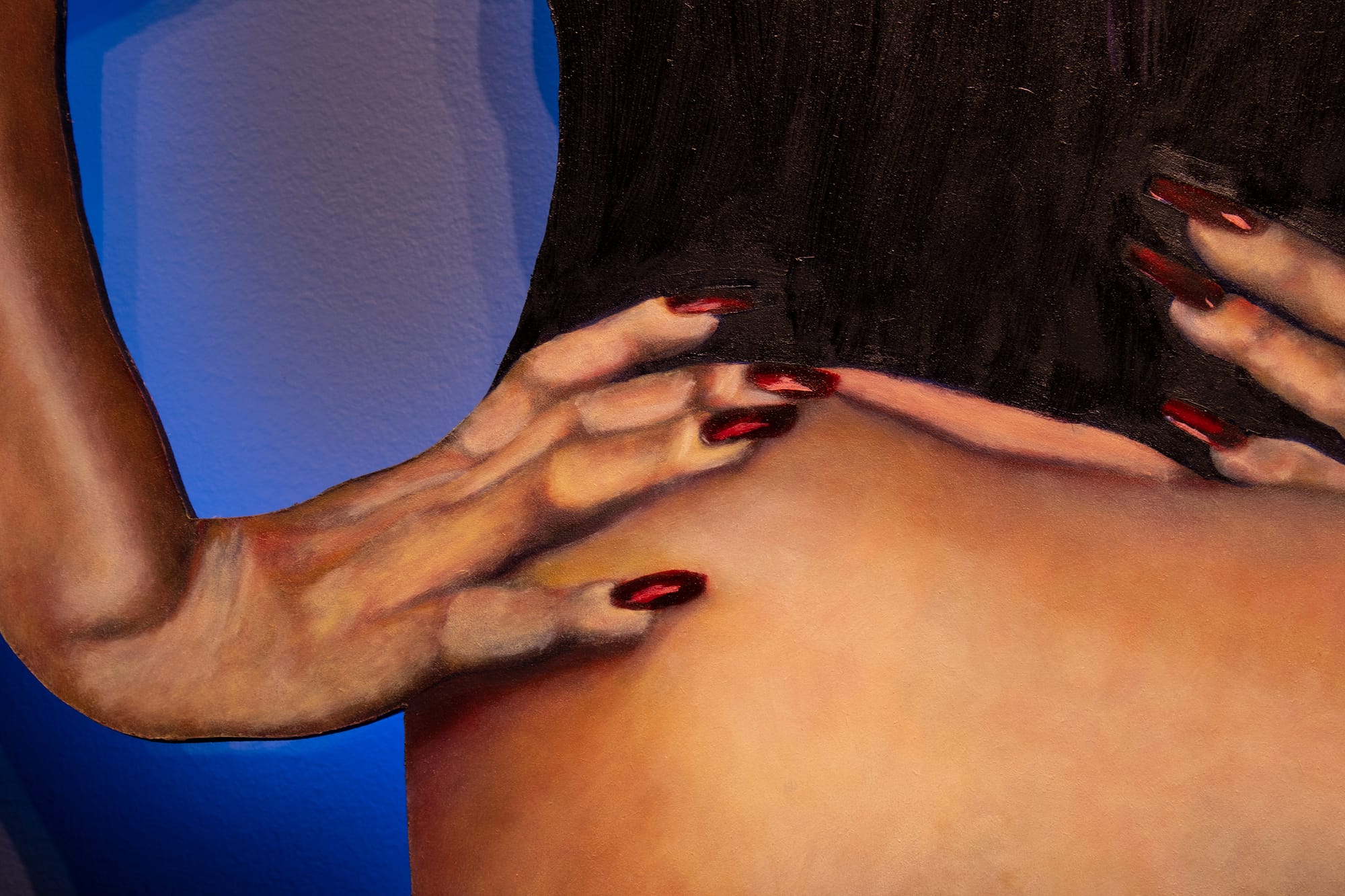
From top left: Lydia Humphreys, “Lounixa Cadaver,” 2024, oil on panel, 95 by 39.5 inches; details of “Lounixa Cadaver." Photos by Olivia D'Laine Schawe for The SHOUT.
In some cases, such as in "Juju Noir" and "Krysta Radiance," vibrant colors are brushed and blended over each other in dry brushstrokes, and thick daubs of bright dots give the impression of sequins. “Juju Noir” poses with her hands on her waist, wearing a bodysuit of black and violet floral pattern, while "Krysta Radiance" appears in a midnight blue dress with a cap and a headdress of brightly colored fronds. The dual portrait "Pseudocidal and Suspicious Glaze" portrays the two performers seated in fleshy suits, each with an arm covered in red tendrils. Here Humpheys applies the paint in a slightly more gestural style, carving out the tangle of implied flesh and eyeliner. Humphreys' technical development and prowess is evident throughout the exhibition, which is a love letter to drag. The body of work is all the more impressive when you learn that the artist made all of the paintings within the last year.
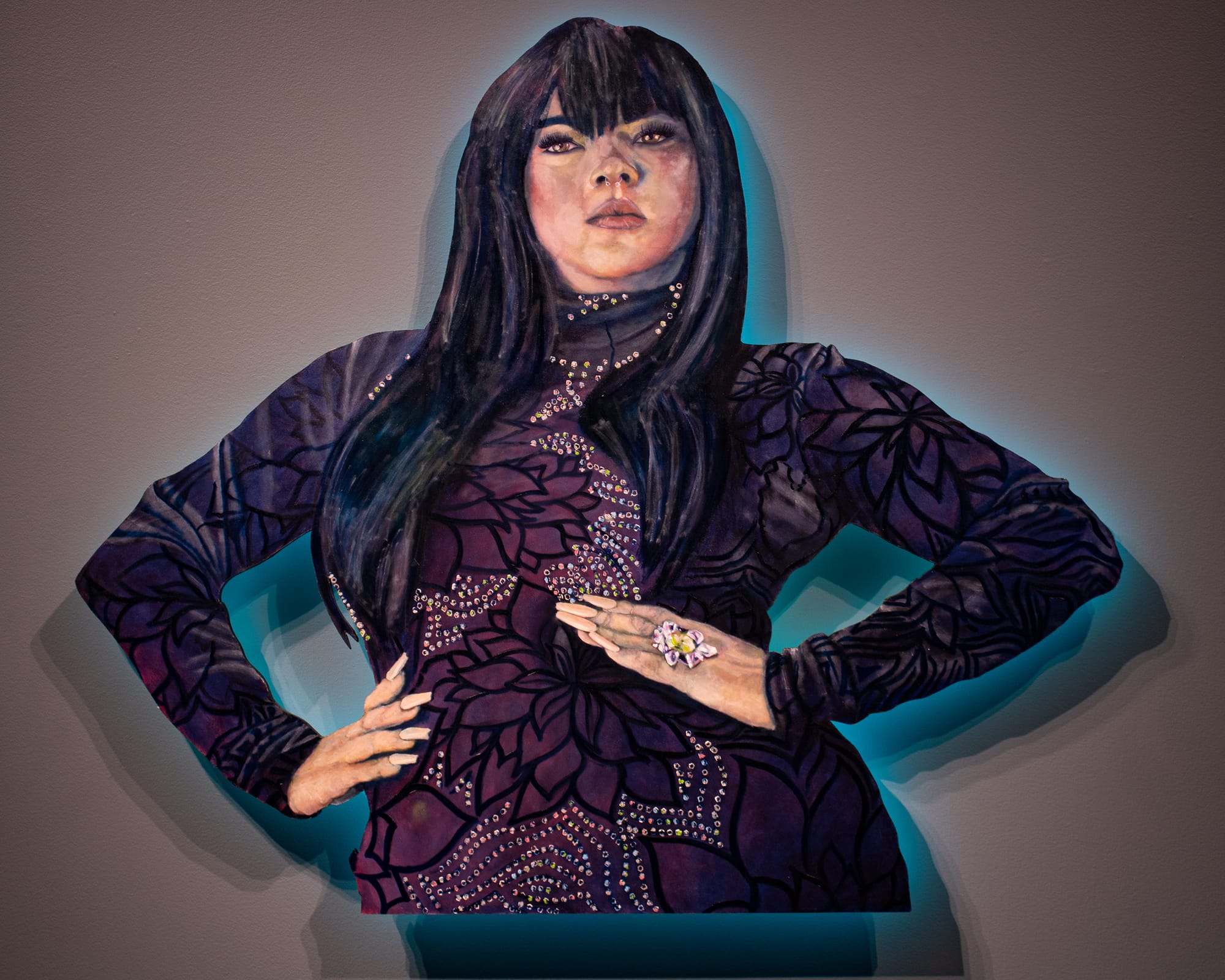
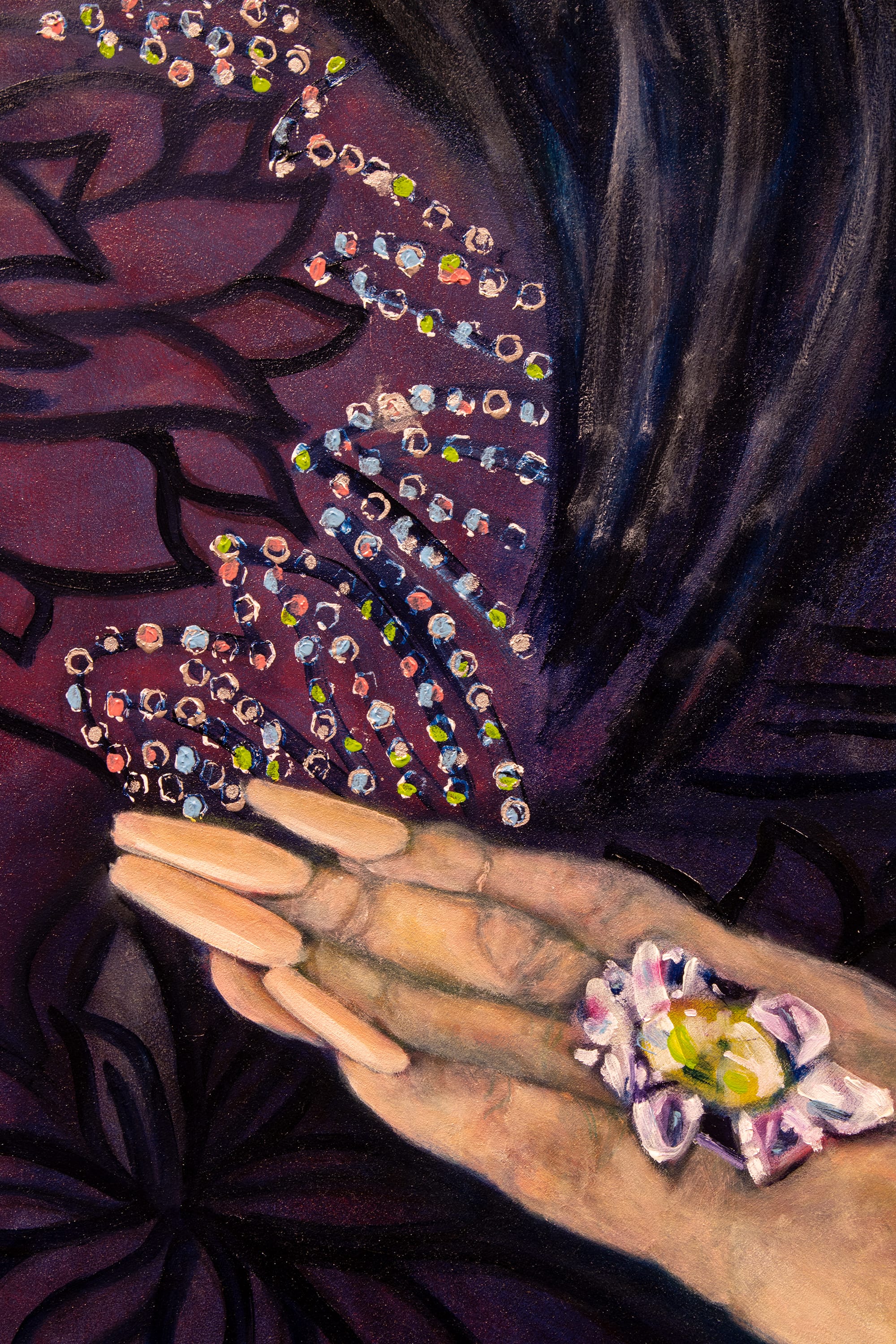
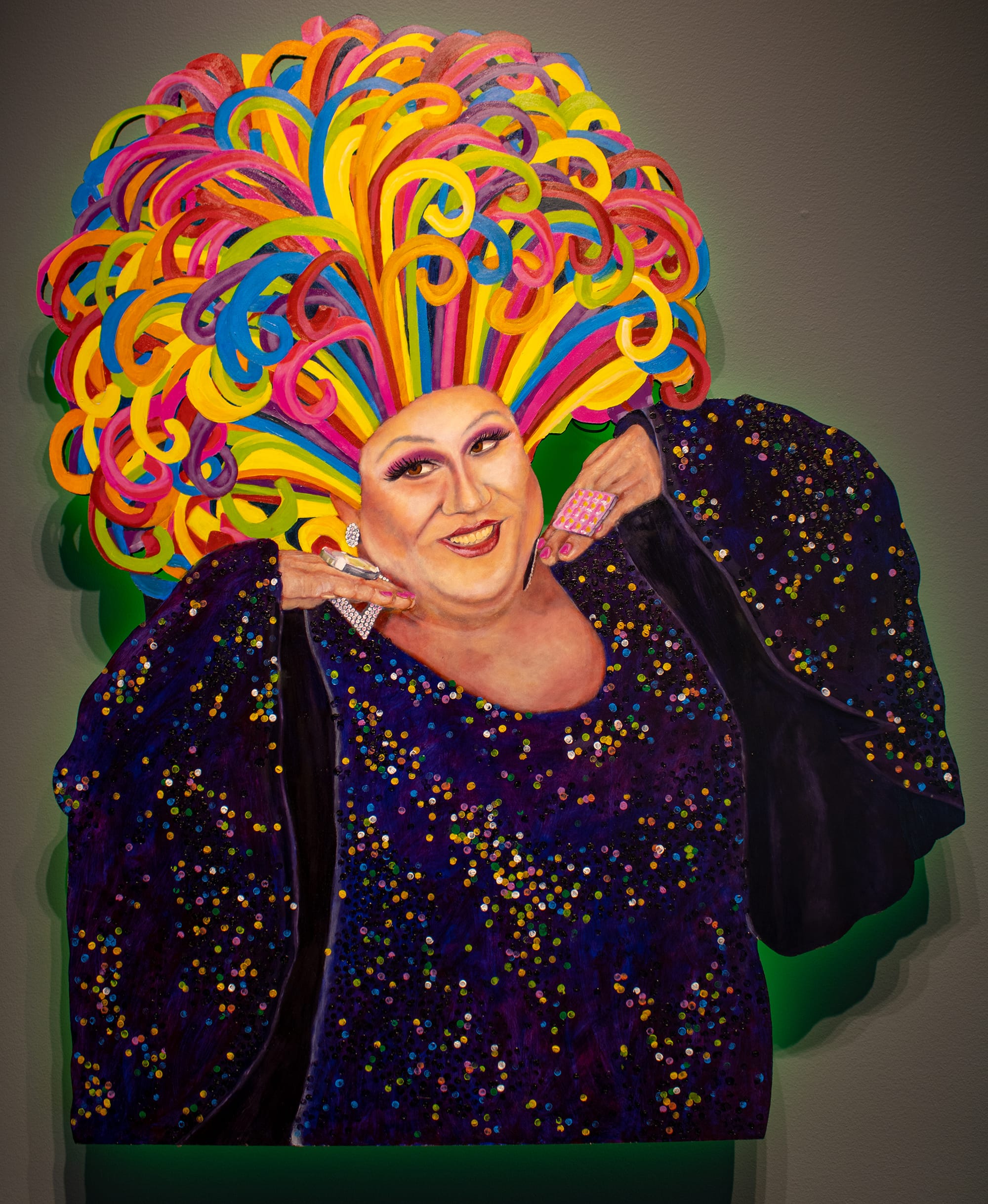
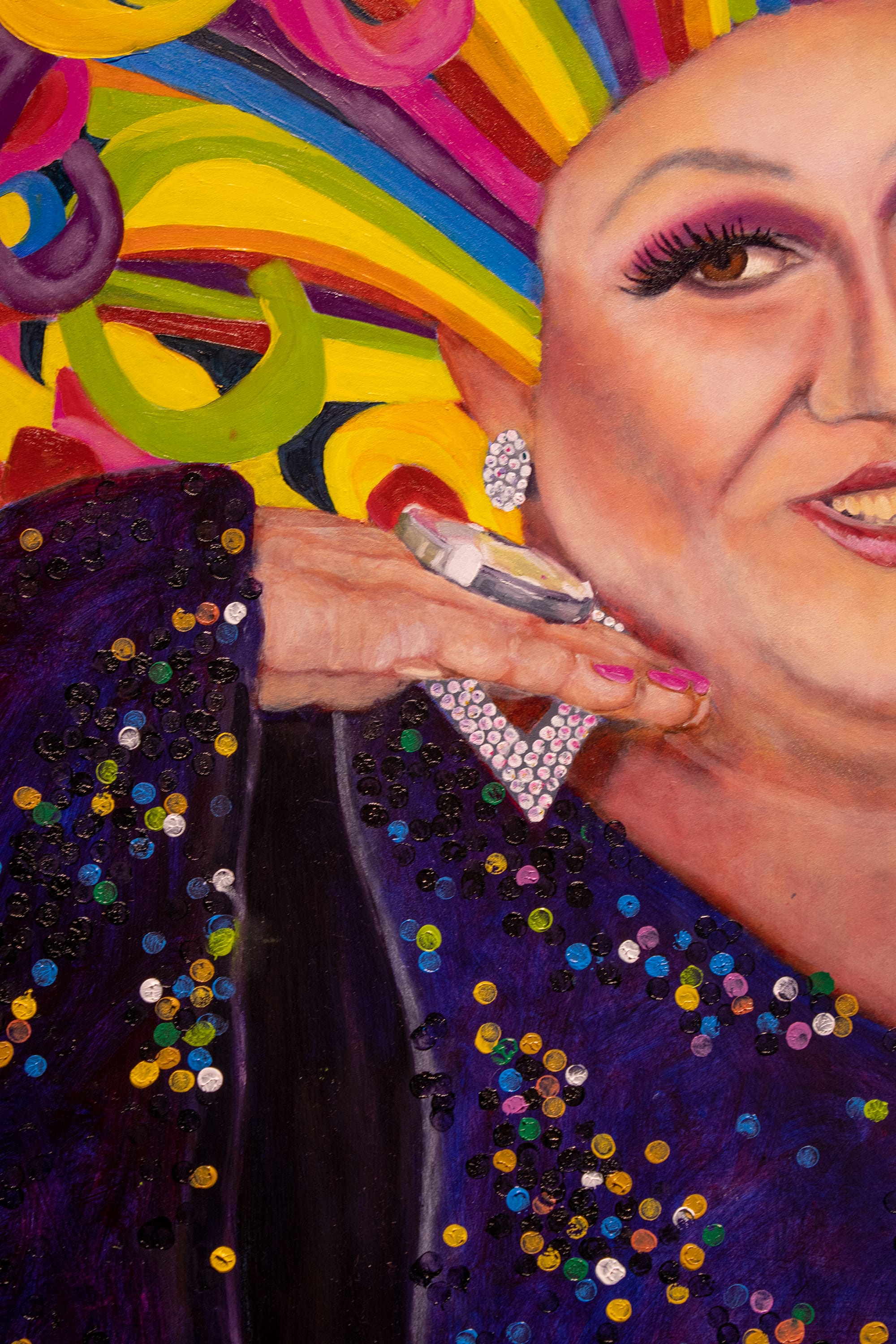
Works by Lydia Humphreys, from top left: “Juju Noir,” 2024,, oil on panel, 48 by 56 inches; detail of "Juju Noir;" “Krysta Radiance,” 2024, oil on panel, 56.5 by 47 inches; detail of “Krysta Radiance." Photos by Olivia D'Laine Schawe for The SHOUT.
The scale of Humphreys’ oil paintings contributes to the sensation of reverence they impart. Roughly life-size or larger, they allow the viewer to get in close and admire the details of the clothing and accoutrements, both in the painting itself and in the craftsmanship of the drag artists (many of whom construct their own outfits). In the portrait "Juju Noir" you can practically hear the click of Noir’s thick acrylic nails against the rhinestones on her bodysuit.
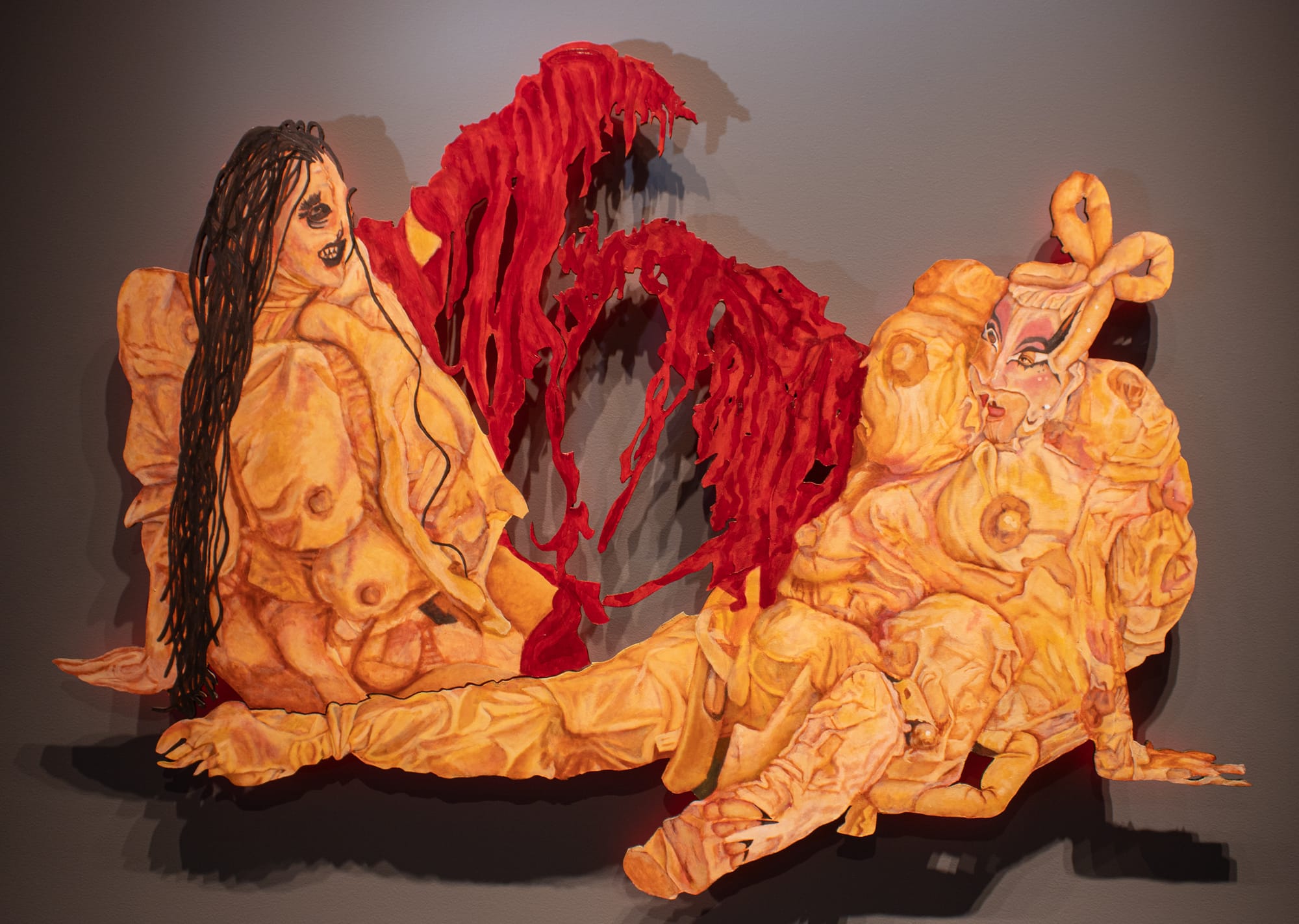
Lydia Humphreys, “Pseudocidal and Suspicious Glaze,” oil on panel, 2024. Photo by Olivia D'Laine Schawe for The SHOUT.
Humphreys’ attention to depicting the performers’ outfits is a key part of these portraits. Much of drag artistry lies in contemporary understandings of fashion and how it can be magnified, exaggerated, challenged, broken down, and rebuilt. For example, the subject in "Reign Regalia" lives up to her royal title through her dramatic, mandorla-like crown of gold lilies and outfit of lush fabrics and plaits of embroidery encrusted with gems. The portrait conveys a sense of regality — a savoring of the self. What I imagine the figure is tasting as she puts her finger to her tongue is a dribble of the nectar fallen from her crown of lilies, the aura of purple perfuming the space with the scent, and the fallout of pollen sprinkling her cheeks.
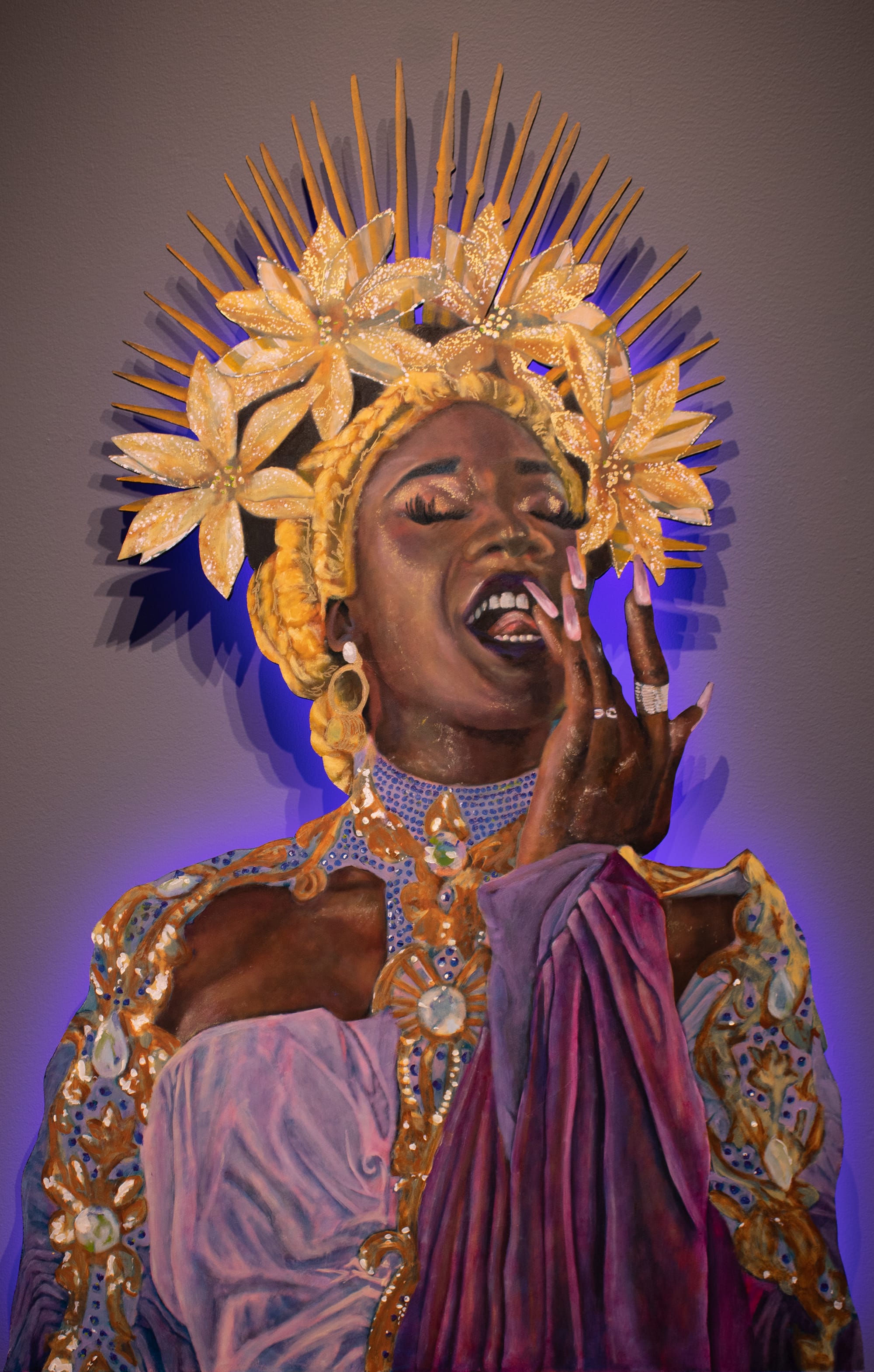
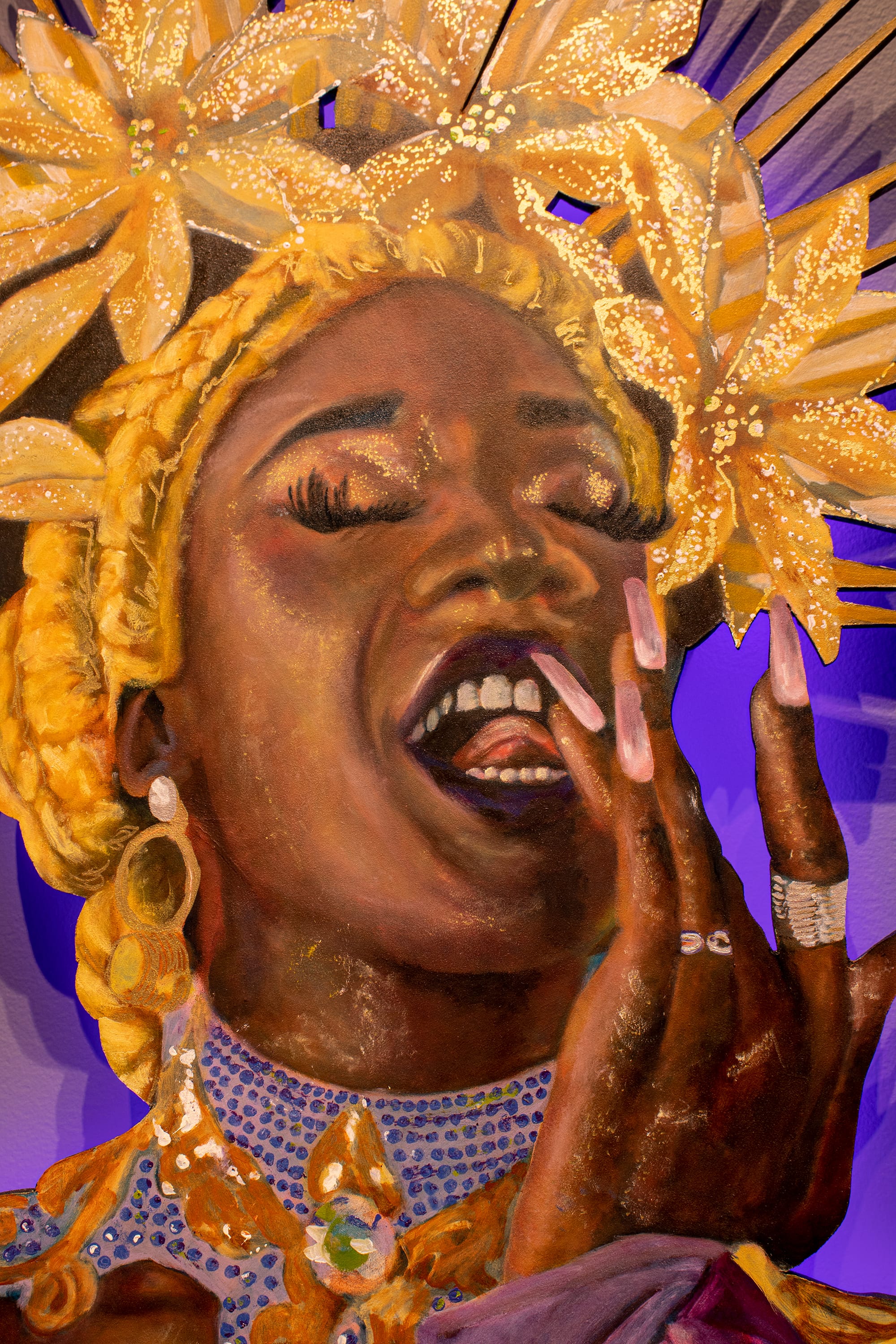
From left: Lydia Humphreys, “Reign Regalia,” 2024, oil on panel, 57 by 36 inches; detail of “Reign Regalia." Photos by Olivia D'Laine Schawe for The SHOUT.
On another wall the masked "FaeTality KO Kotoure" sits in demure reflection wreathed in voluminous, Lolita-inspired frills. Elsewhere, "Dougie No-Nuts" embodies the spirit of a sailor, a monstrous jaw with delicate chains draped around their shoulders, their face painted a ghostly white, and one eye covered with a pale fog.
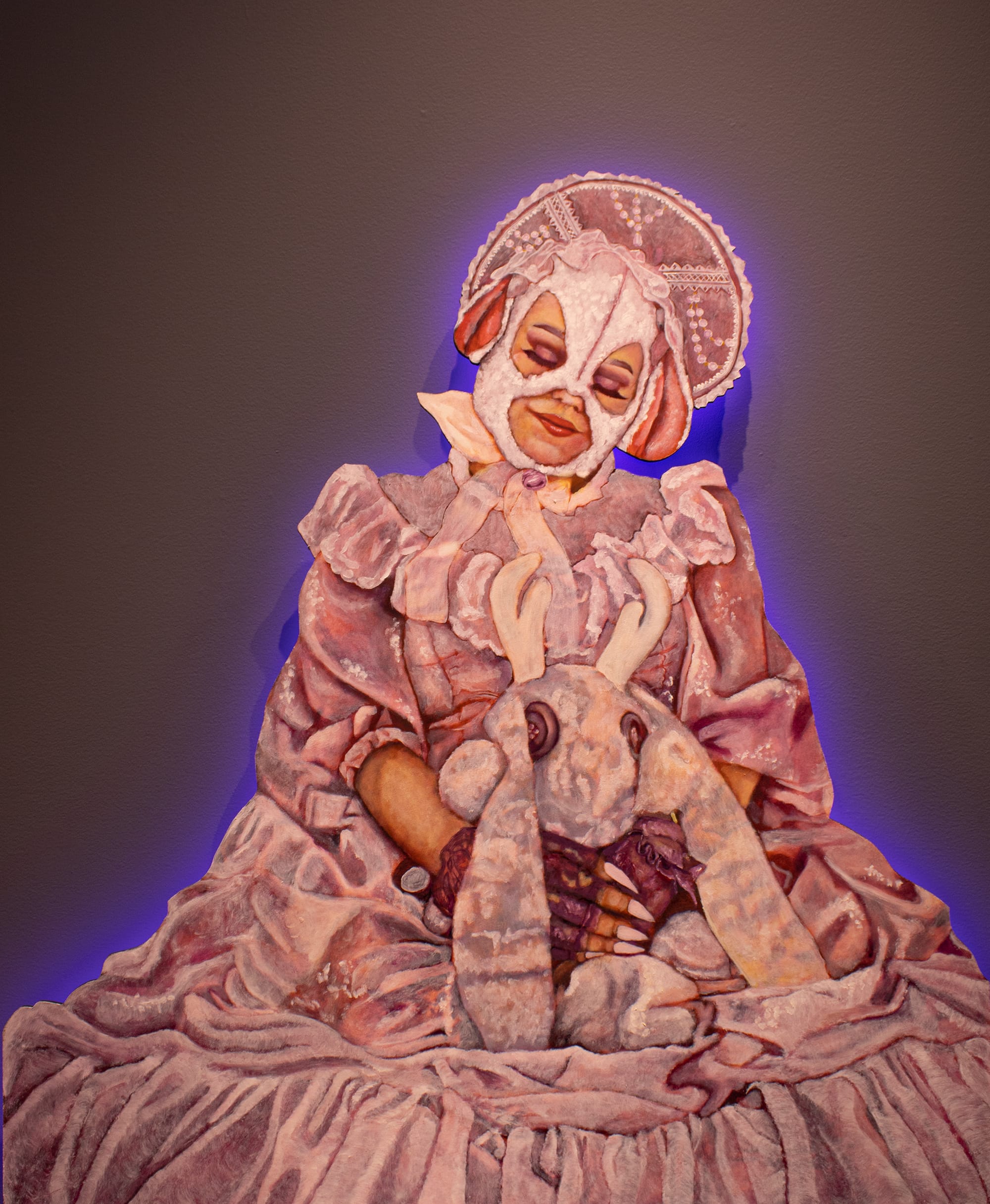
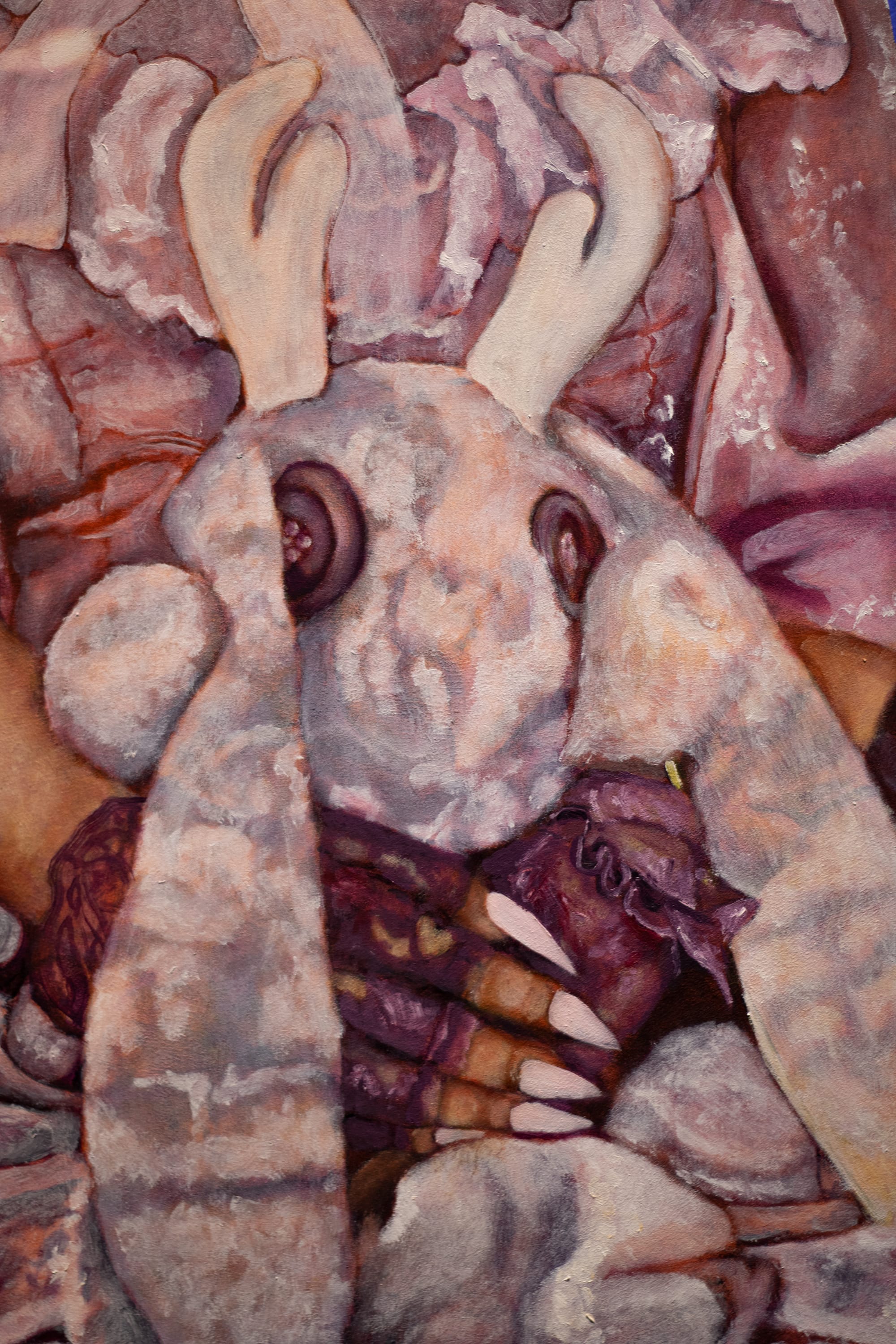
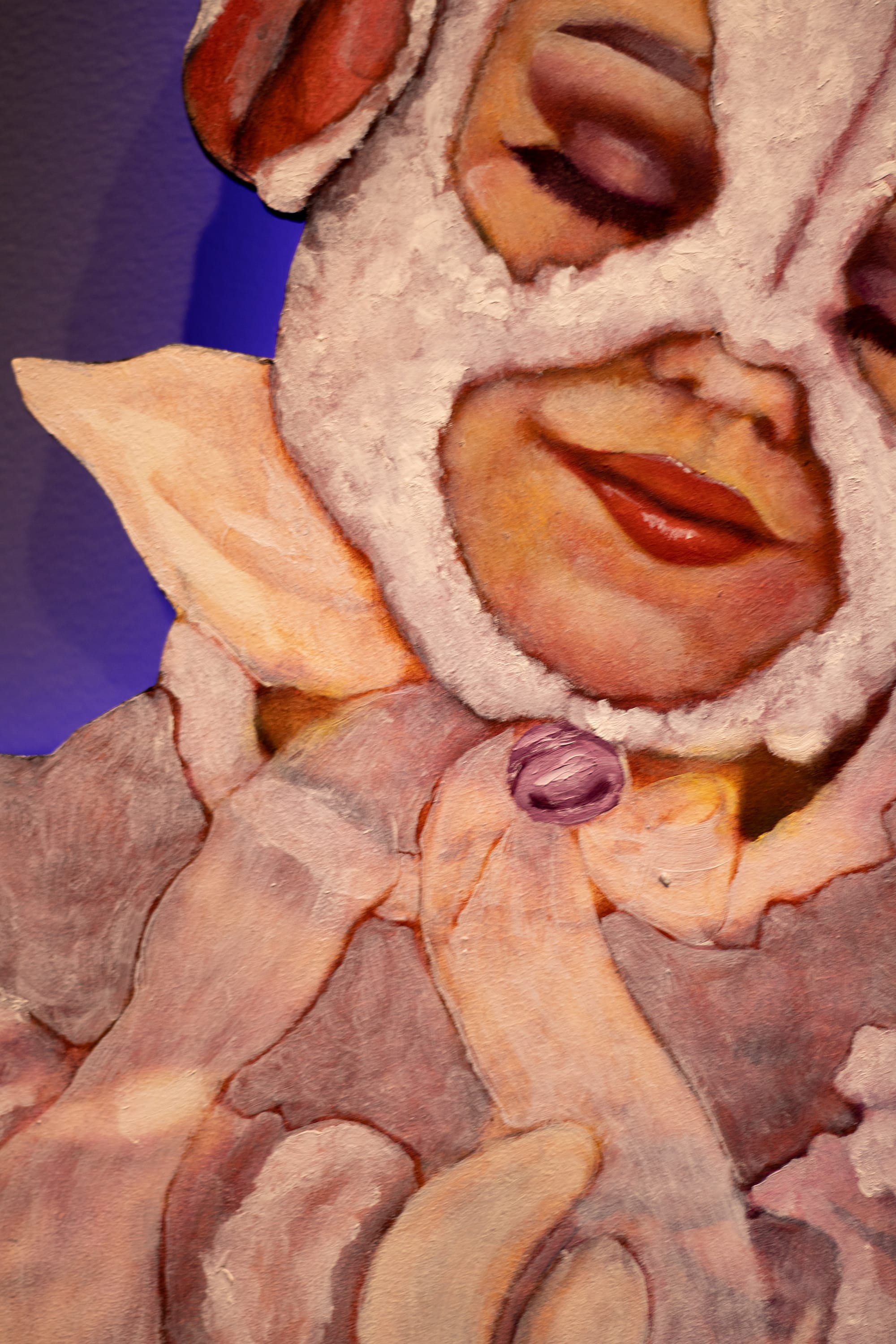
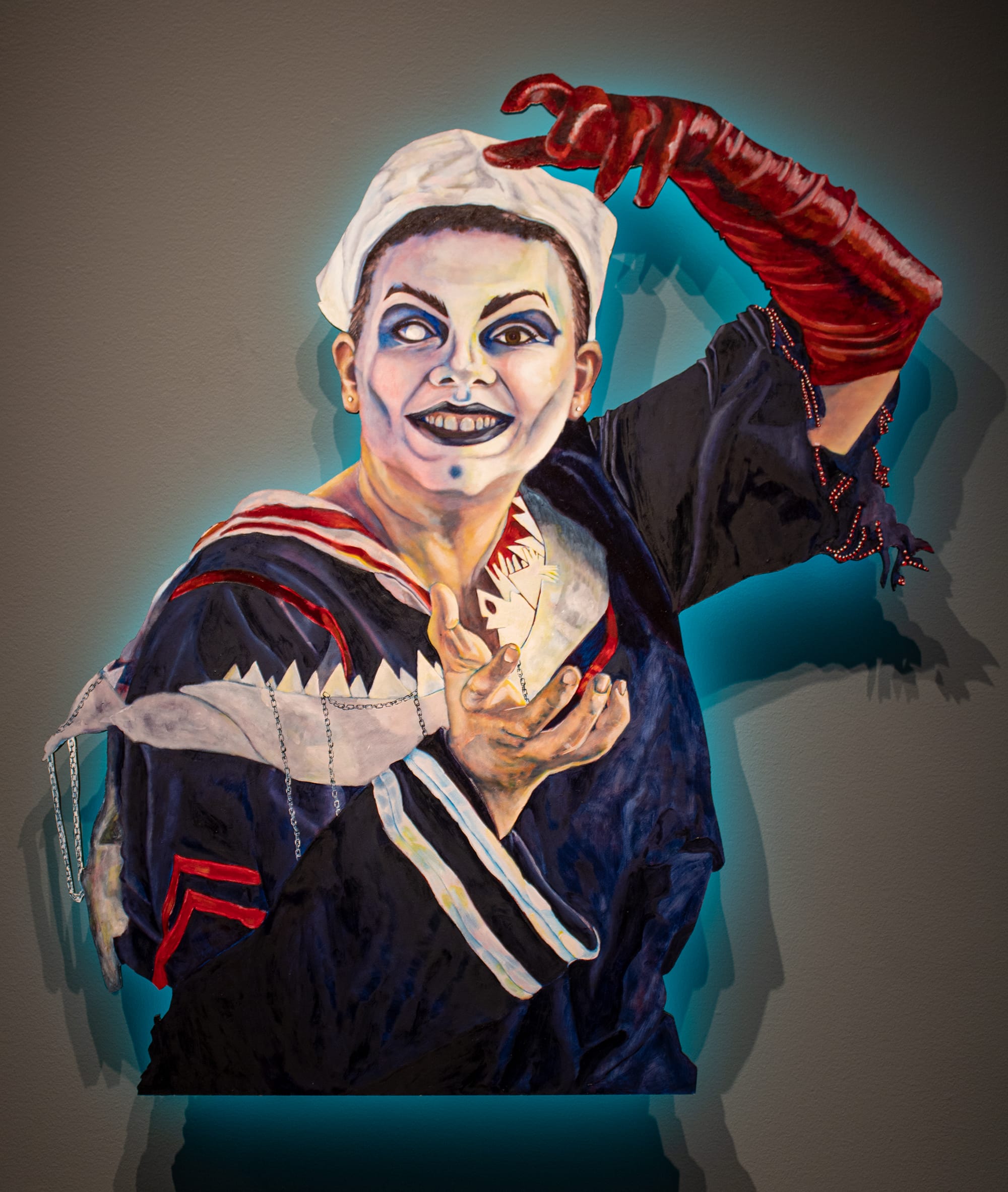
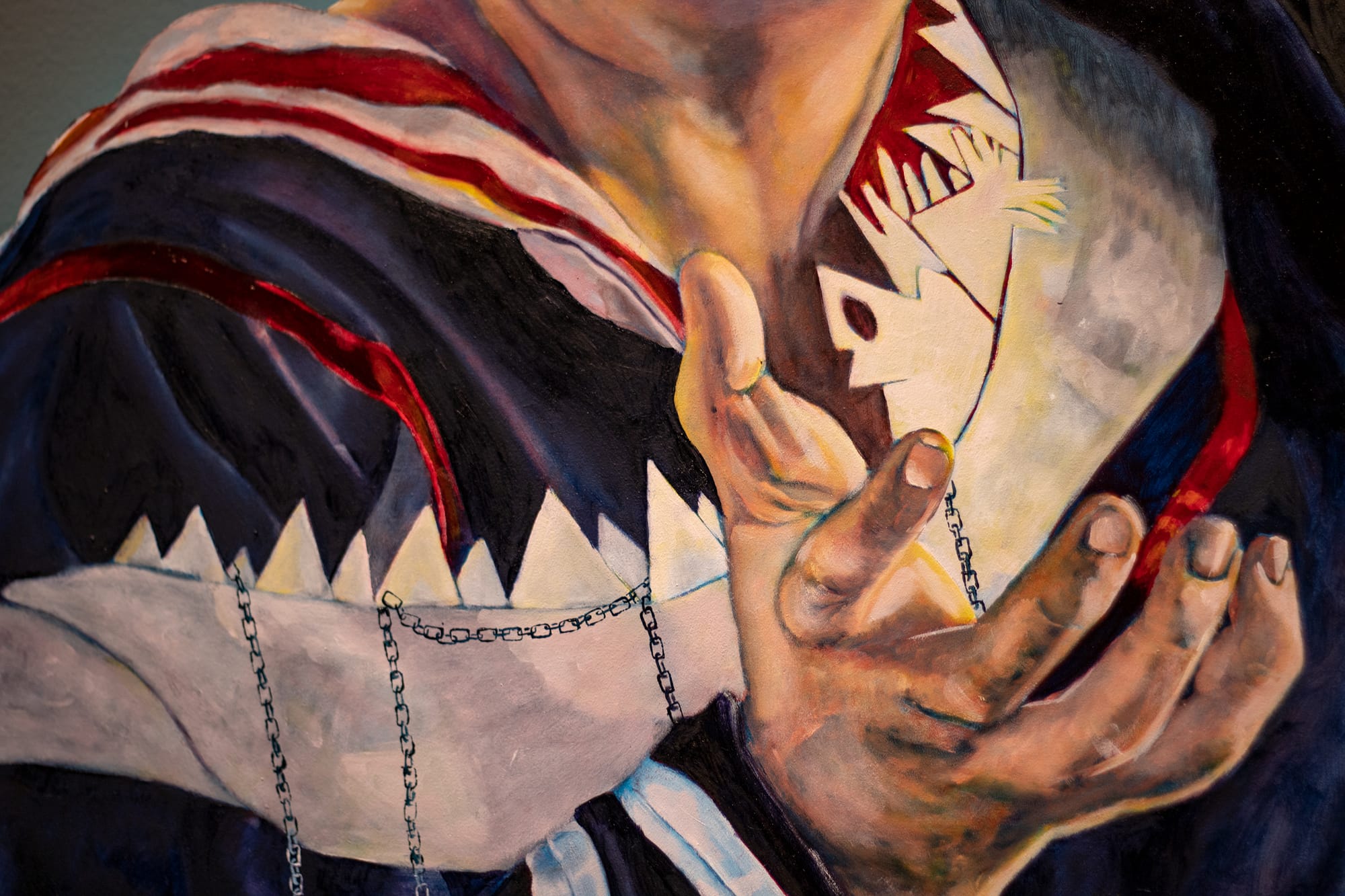
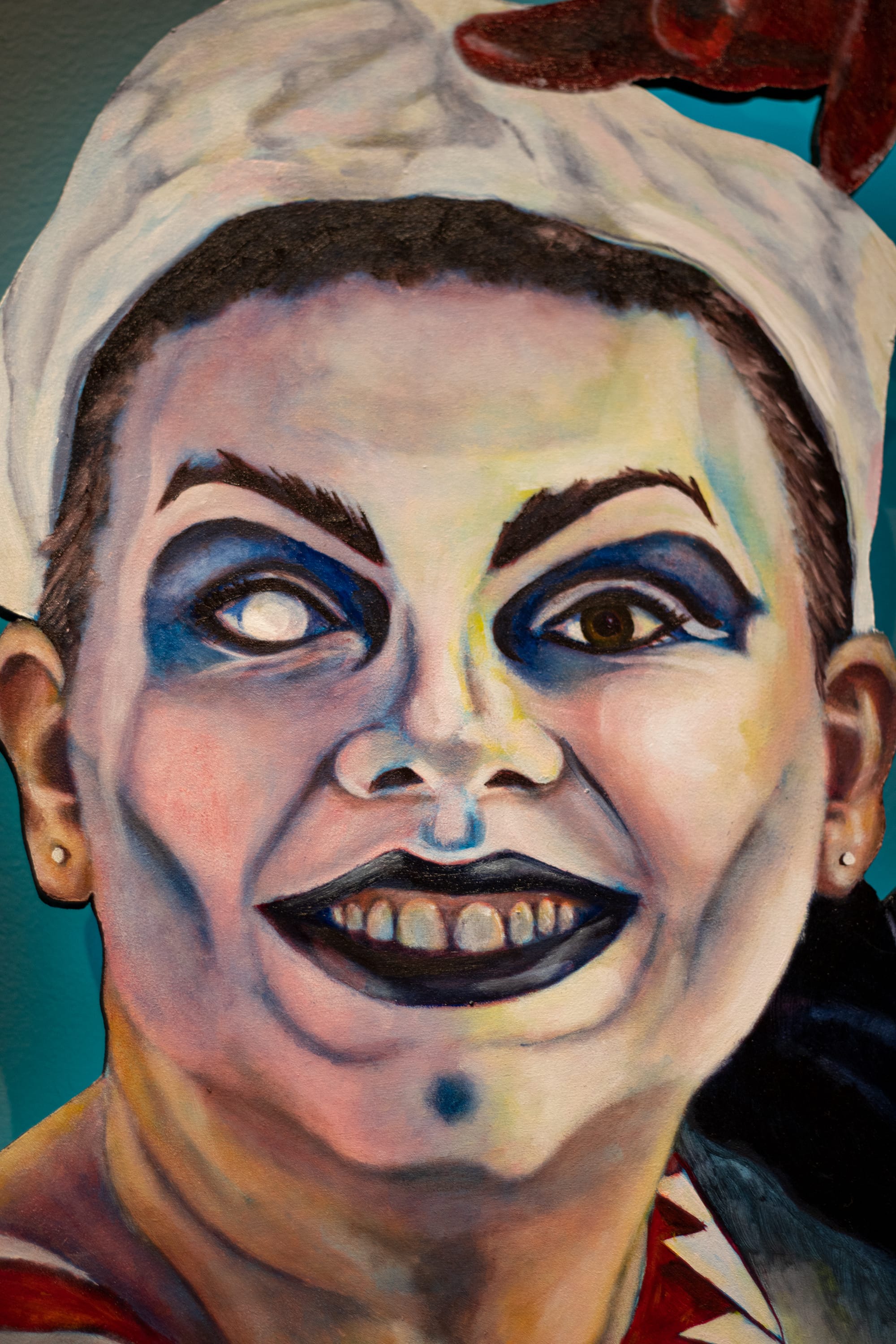
Works by Lydia Humphreys, from top left: “FaeTality KO Kotoure,” oil on panel, 2024; details of “FaeTality KO Kotoure;" “Dougie No-Nuts,” 2024, oil on panel, 49 by 45 inches; details of “Dougie No-Nuts." Photos by Olivia D'Laine Schawe for The SHOUT.
To many, drag is defined by a person parodying or “impersonating” a gender along opposite or opposing gender lines — but that’s not always so! Several of the subjects demonstrate the diversity of the performance genre through their use of "monster drag," a term I learned from none other than the performer named Deadnettle. In the exhibition, Deadnettle appears alongside Aero Decay, Pseudocidal, Suspicious Glaze, Effi Darling, and Dougie No-Nuts, demonstrating the spectrum of monstrous-meets-glamorous. Through these paintings, Humphreys legitimizes and shows off the range of possibility within drag, all of which is present in Wichita.
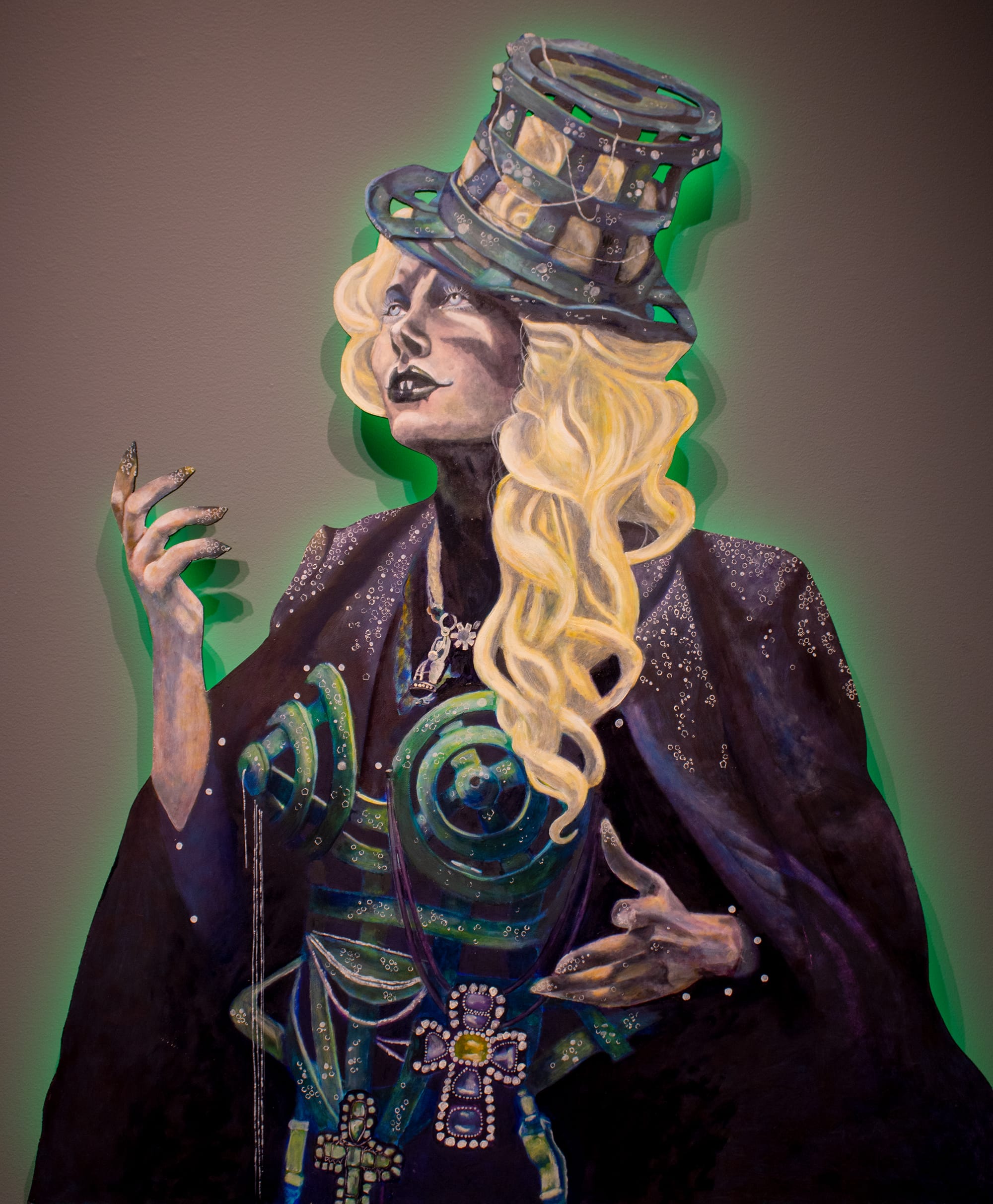
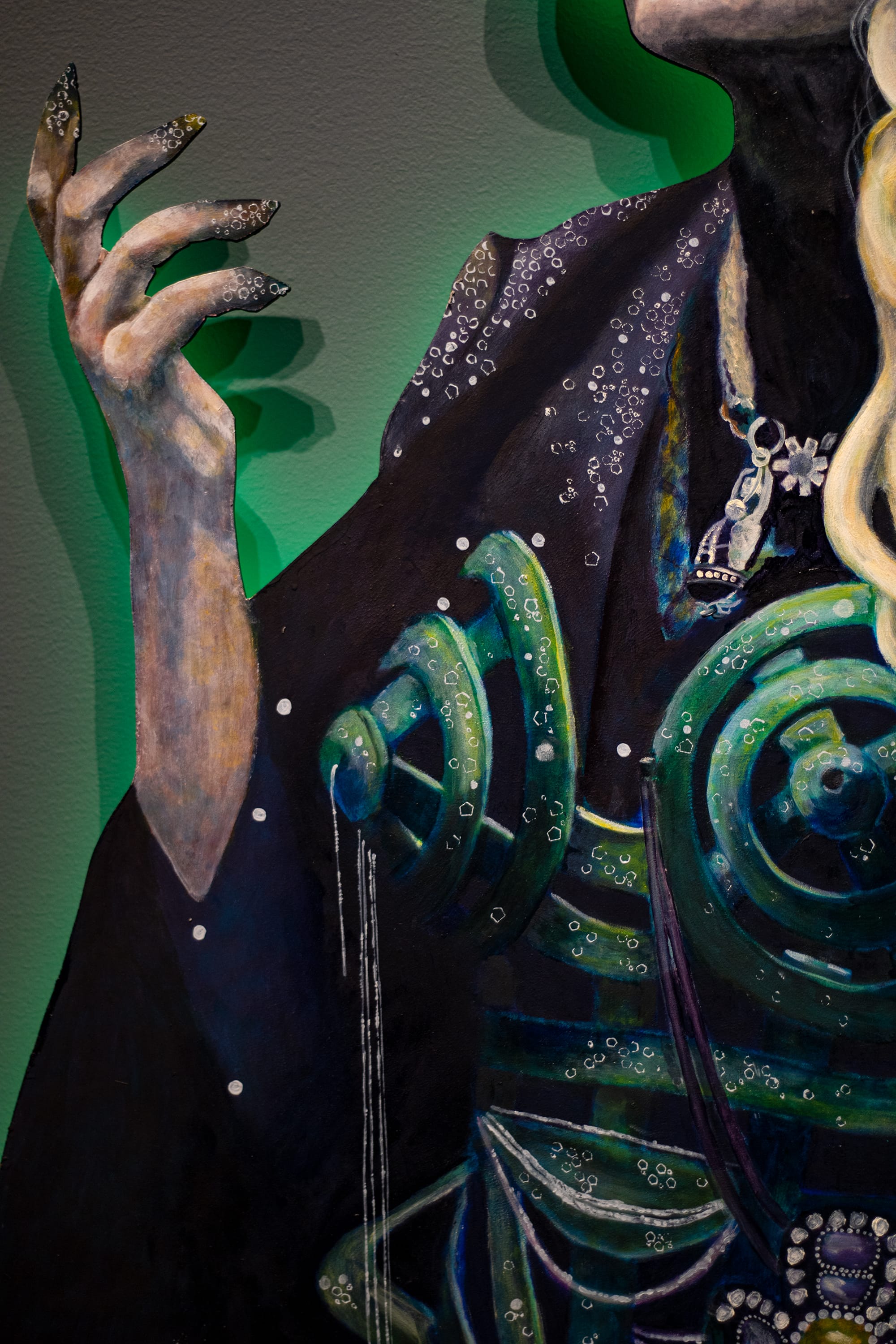
Lydia Humphreys, “Deadnettle,” oil on panel, 2024; detail of "Deadnettle." Photos by Olivia D'Laine Schawe for The SHOUT.
The artist also gives each portrait in the show its own halo of light. Humphreys suspends the shaped paintings on wood slightly away from the wall and attaches LED lights behind them. The light provides an ambience for the individual drag artists, adding to the otherworldly feeling of each persona and setting them apart from one another while unifying the show.
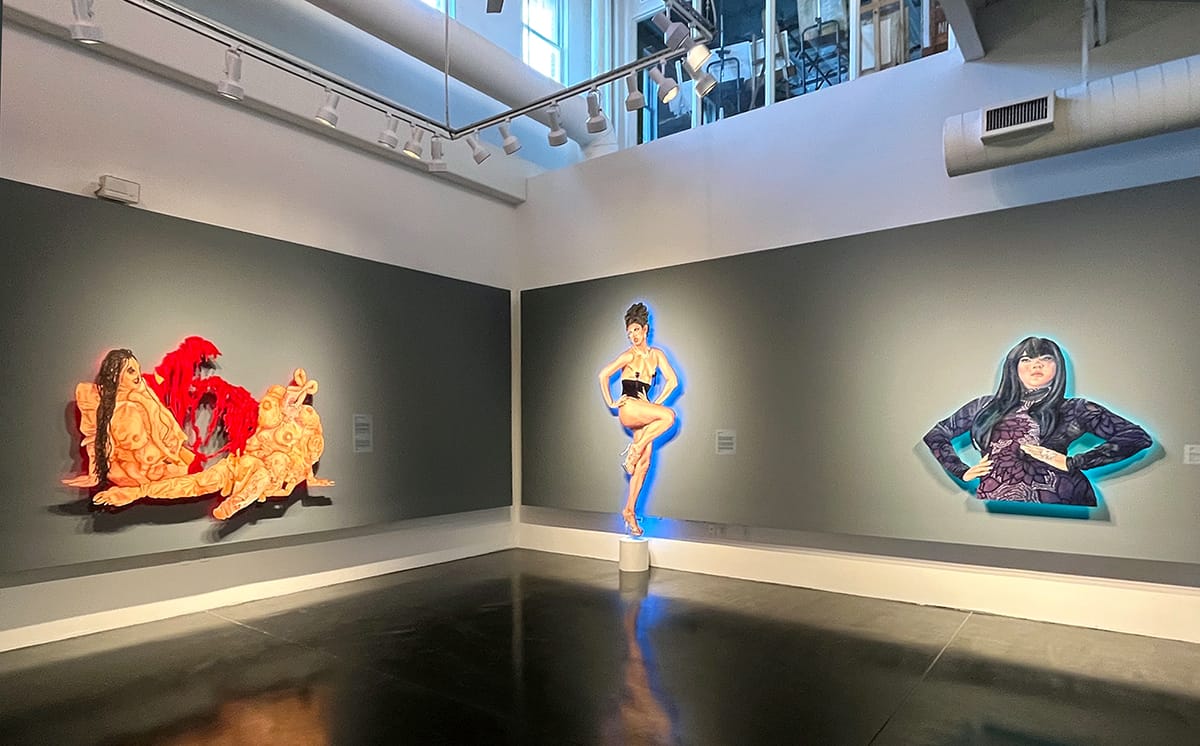
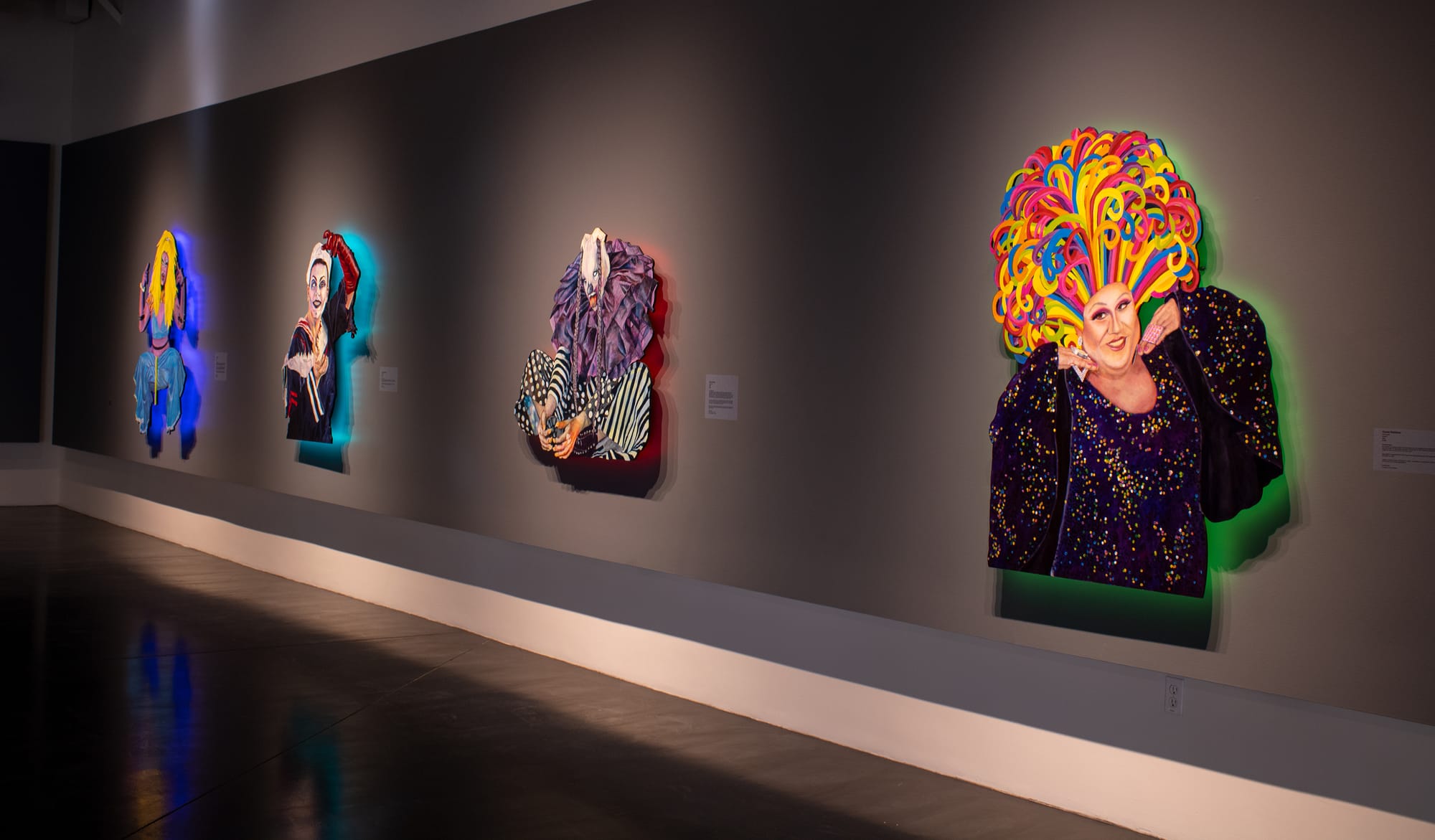
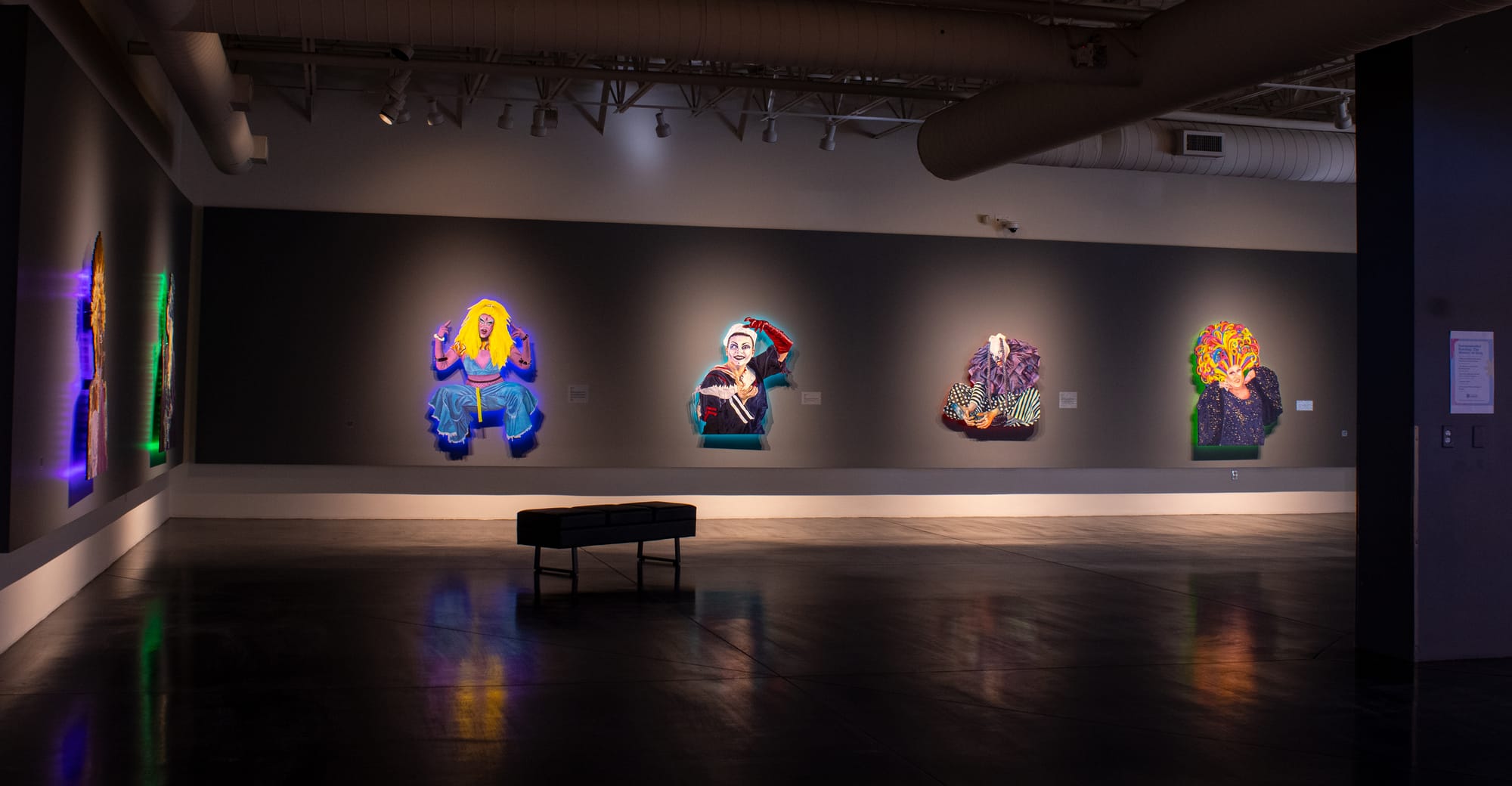
Daytime and nighttime views of "The Fluidity of Expression." Photos by Olivia D'Laine Schawe for The SHOUT.
I first encountered Lydia Humphreys’ artwork in their Master of Fine Arts thesis show "Changing the Narrative" at Wichita State in 2022. The important and bitter work in this earlier exhibition centered on the experiences and perspectives of survivors of sexual violence. In the growing body of drag portraits that make up “The Fluidity of Expression,” the lighthearted nature of these paintings seems to stand in significant contrast to the seriousness of the works I first encountered. However, the core value at the heart of Humphreys’ practice is evident. Stated simply, a person’s body is their own. Desire, stigma, and legislation cannot and should not overrule that fundamental fact.
The “Fluidity of Expression” exists at a moment when drag artists are a convenient target for cultural warriors, and it’s refreshing to see a celebratory approach to such a politicized topic. Humphreys’ work honors the queer community, which lifts up its members in times of turmoil. This exhibition reminds us that queer life is a life that we choose for ourselves.
The Details
"The Fluidity of Expression," an exhibition by Lydia Humphreys
January 10-February 23, 2025 in the Main Gallery at CityArts, 344 N. Mead in Wichita
A First Friday reception will take place from 5-8 p.m. on February 7 at the art center in Old Town Square.
CityArts is open to the public 9 a.m.-8 p.m. Monday-Thursday, 9 a.m.-5 p.m. Fridays, 9 a.m.-3 p.m. Saturdays, and noon-5 p.m. Sundays.
Admission is free.
A Wichita Public Library poster hanging in the gallery recommends the following books about the history of drag:
- "Who Does That Bitch Think She Is? Doris Fish and the Rise of Drag" by Craig Seligman
- "The Big Reveal: An Illustrated Manifesto of Drag" by Sasha Velour
- "And Don't F&%k It Up: An Oral History of RuPaul's Drag Race" by Mara Elena Fernandez
- "Karaoke Queen" by Dominic Lim
- "The House of Hidden Meanings: A Memoir" by RuPaul
All are available for check-out from the WPL.
"The Fluidity of Expression" is an expansion of an earlier exhibition of Humphreys' at Harvester Arts from June 7-28, 2024.
Olivia D'Laine Schawe is a teaching artist living in Wichita, Kansas. Schawe is a recent graduate of Wichita State who works to foster community-based arts practices.
More from the SHOUT
 The SHOUTSam Jack
The SHOUTSam Jack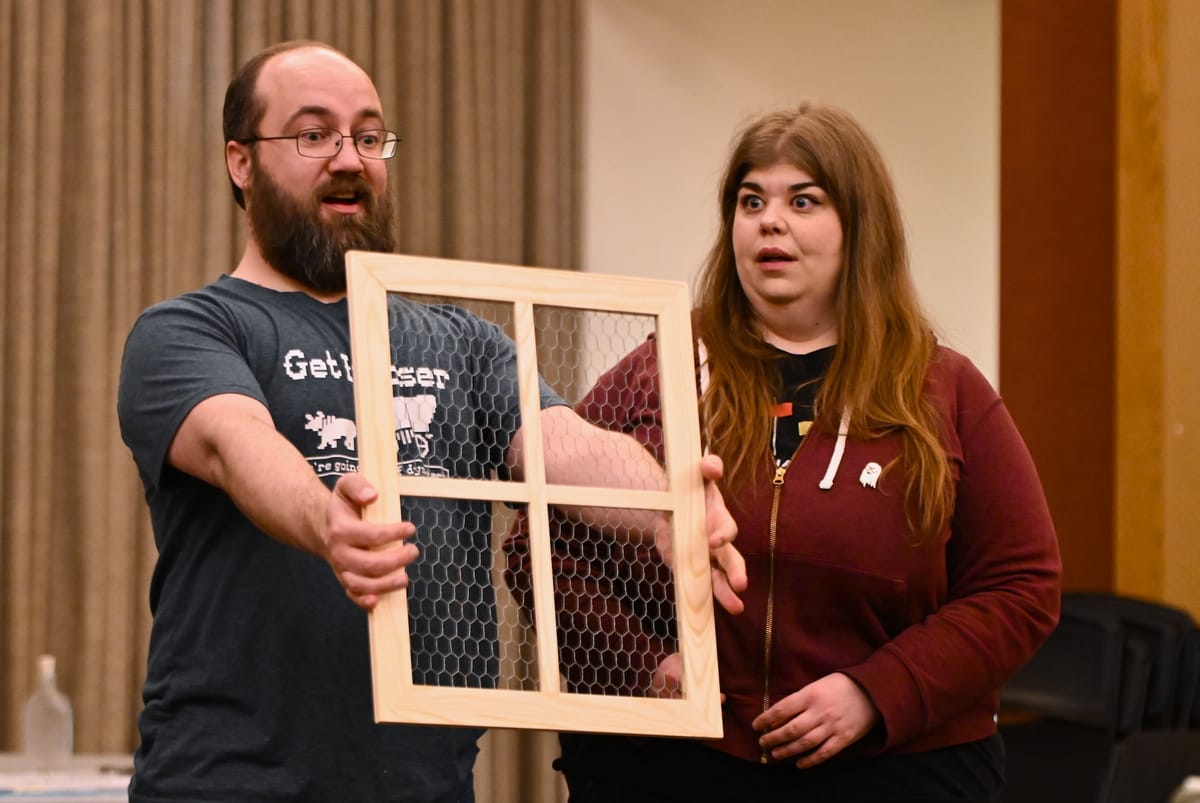
 The SHOUTConnie Kachel White
The SHOUTConnie Kachel White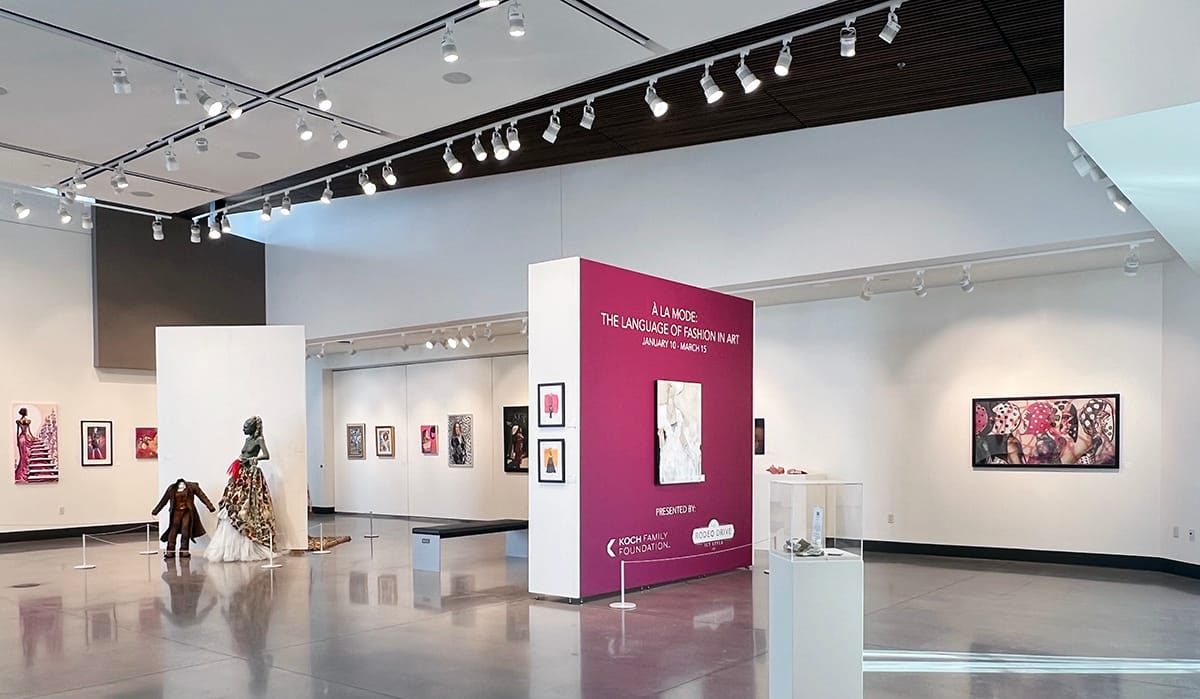
 The SHOUTKevin Kinder
The SHOUTKevin Kinder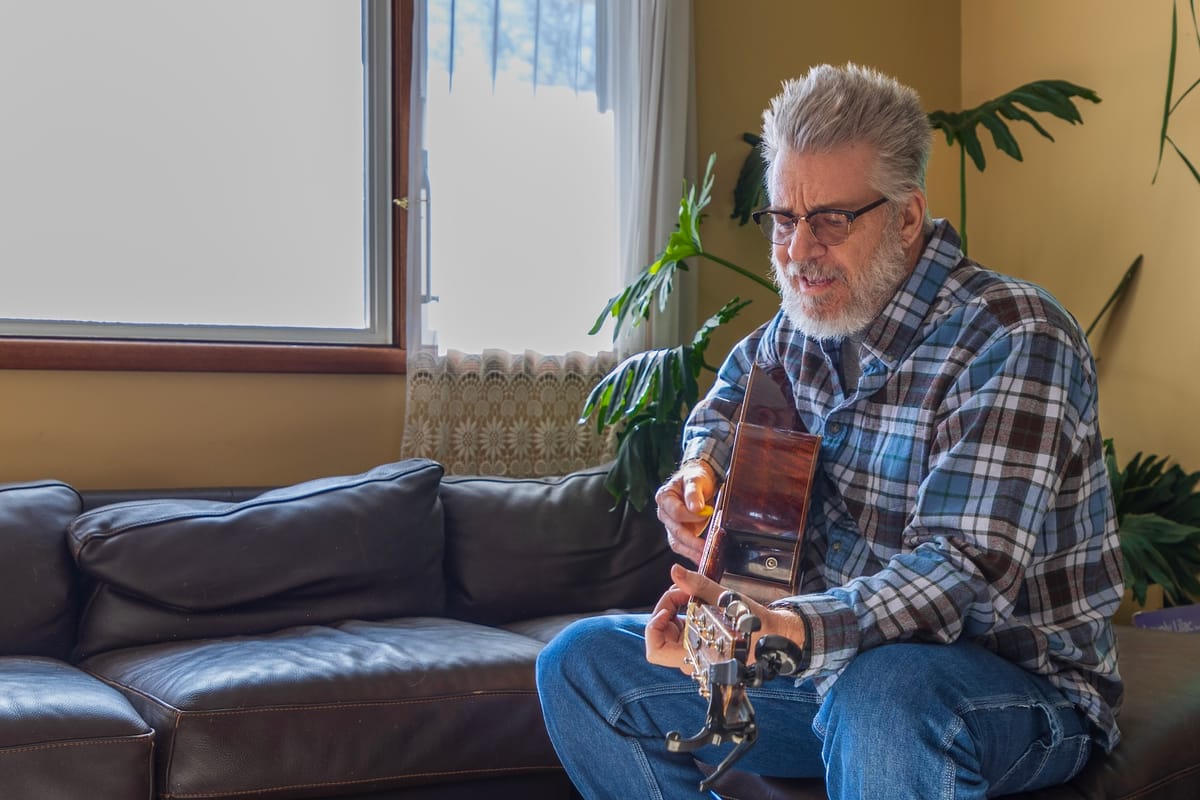
 The SHOUTKevin Kelly
The SHOUTKevin Kelly